
Cloud Hands Homepage
Videos Online Descriptions and Instructions for the 24 Movements Performance Time Martial Arts
Strategies for Learning the Tai Chi 24 Form Cloud Hands Website Cloud Hands Blog Chen 18 Hunyuan 24
Taijiquan 24 Form Webpage - Translate this Webpage into a Language Other than English
T'ai Chi
Ch'uan: National 24 Form
Standard Simplified Taijiquan Version, 24 Movements,
1956, Yang Style Taijiquan
24 Short Form, Simplified Tai Chi, Standard
Beijing Taijiquan
24 Form, Chinese National 24 Form Taiji
Chen Chang Xing (1771-1853) developed the Chen Style T'ai Chi Ch'uan (Taijiquan) Old Frame, First Routine. He taught the Chen Style Taijiquan to Yang Lu Chan (1799-1872), who developed the Yang Style of Taijiquan. The grandson of Yang Lu Chan, Yang Cheng Fu (1883-1936) modified and popularized the Yang Style Taijiquan, and published a number of books on the subject in the 1930's.
In 1956, the National Physical Culture and Sports Commission of the People's Republic of China, under the leadership of the Taijiquan Committee Chairperson, Professor Li Tian Ji, developed standardized and simplified versions of many T'ai Chi Ch'uan (Taijiquan) forms. Professor Li Tian Ji (1914-1996) led the development of the 24 Taijiquan Form and the 32 Sword Taijiquan Form as well as many other standardized Taijiquan forms, and he is called by many "The Father of Modern Taijiquan."
The Standard Simplified Beijing 24 Taijiquan Form was based on the Yang Family style of T'ai Chi Ch'uan, as epitomized by Yang Cheng Fu. The 24 Taijiquan Form could be performed in 4 to 8 minutes, and consisted, as would be expected, of 24 movements, although some of the movements have two or three parts. The 24 Taijiquan Form eliminated some of the movements that are found in the Yang Style Taijiquan 108 long form such as the Sweeping Lotus Kick, Step Up to Seven Stars, Snake Darts out its Tongue, or Carry the Tiger to the Mountain. The short 24 Taijiquan Form also greatly reduced the number of times that some movements are repeated in the Yang Style 108 long form such as Grasping the Sparrow's Tail, Waving Hands Like Clouds, Left Ward Off, or Single Whip. The traditional Yang Style Taijiquan long form has 108 movements (postures or parts).
The Standard Simplified 24 Taijiquan Form, the short form, could be taught fairly quickly to students of various ages in physical education programs. The brevity of the form appealed to students of all ages. The short form could be done by large groups of people in rows since the movement choreography is in straight lines. The short form provided a standard form for use in some competitions. The new short form was less physically demanding than longer forms and other Tai Chi styles, and appealed to older beginners. It provided a good introduction to the basic elements of the Yang Family Taijiquan long form. When done properly, the short form can exemplify grace, beauty, and many fundamentals of the art. For these reasons, the Standard Simplified 24 Taijiquan Form has become quite popular and is now taught, practiced and played all over the world.
Forty years ago it was difficult to say whether the Standard 24 Form or the Cheng Man-Ch'ing 37 Form were the most popular in America. Professor Cheng's form, his inspired teaching, his many accomplished students, and his amazing push hands skills, all definitely sparked very sophisticated writing on the subject and intense commitment to his form; and his 37 short form was the most popular in America before 1977. Now, students have ready access to many more English language books and instructional media (DVDs and VHS videotapes) about the Standard Simplified T'ai Chi Ch'uan 24 Form, and instructors teaching the 24 Taijiquan Form are quite common in America. Since both forms use Yang style postures and skills, a few Yang style Tai Chi practitioners and teachers can do both the 24 and 37 forms, as well, of course, as the Traditional Yang Style Taijiquan 108 long form. However, in my opinion, the Standard 24 Taijiquan Form, in the Yang Style, is now the most popular Tai Chi form practiced in America and around the world.
Other shortened versions of T'ai Chi Ch'uan long forms are also practiced. A 48 movement Yang short form is also popular in China. The Chinese National Wushu Association has developed a 42 movement Yang style competition form. The Chen style of T'ai Chi Ch'uan also has 11, 18, 19, 36, 38, 56 movement short forms, as well as a Chen competition form of 56 movements. Both an 11 and 35 movement version of the Sun style of T'ai Chi Ch'uan also exist.
I first learned the Standard 24 Taijiquan Form in 1986, and have enjoyed practicing the form since then. To assist others in learning this popular Taiji form, I've prepared this webpage and provided many tools and suggestions for learning the 24 Taiji Form. I also enjoy practicing the Chen Style Taijiquan 18 Movement short form created by Grandmaster Chen Zhenglei.
This webpage was first published on the Internet in 2001. It is one of the more popular webpages on the Cloud Hands website. In 2009, this webpage was served to over 86,000 persons. I made an effort to significantly upgrade the quality of this webpage in 2011, and develop it to the quality of my 32 Taiji Sword Form webpage.
My very best wishes to you in your study and practice of the popular and delightful Standard Tai Chi 24 Form.
From Mike Garofalo, here at the Valley Spirit Center in Red Bluff, California, on April 4, 2016,

Mike Garofalo
Playing the Pi Pa
"No school of Chinese martial arts is as well known and popular as Taijiquan. It is suitable for both the young and the old, not only because Taijiquan possesses special features of stretching, flexing the joints, softly twining, exercising both the inside and the outside, dispelling diseases and prolonging life, but it is also the martial art that best reflects Chinese traditional philosophy. More and more people from other countries, especially those interested in Chinese culture, are beginning to practice Taijiquan. Taijiquan is becoming popular all over the world. Because of this, Taijiquan has no national boundary and is beyond the category of culture, and belongs to people everywhere.".
- Fan Chun-Lei and A. Frank Shiery, Traditional Chen Style Taijiquan
Study Yang Style T'ai Chi Ch'uan with Mike Garofalo in Red Bluff, California
Return to the Main Index for this Webpage
Links, Bibliography, Resources
T'ai Chi Ch'uan: National 24 Form
Taijiquan
Standard Simplified
Taijiquan, 24 Movements, 1956, Yang Style, Bejing (Peking) National Form
A Note to Readers: The
Cloud Hands website has been online continuously since 2001.
In 2009, over 1,350,000 webpages (excluding graphics) were served to readers
around the world from the Cloud Hands website.
Since 2005, I have also provided an associated
blog to point to changes and
additions at the Cloud Hands website:
Cloud Hands: Mind/Body Movement Arts
Blog.
Since Cloud Hands is a very well-established and stable website, it provides
readers with a good and secure starting point for their online research into
Taijiquan and Qigong. The Cloud Hands website is funded entirely by
Green Way Research, with
volunteer efforts by Michael P. Garofalo.
Unfortunately, as everyone knows, many other websites and webpages appear and
then disappear from the Internet scene. Authors do not pay to keep up
their web hosting services, loose a "free hosting" option, or decide to remove
webpages for various reasons. Consequently, links to some good webpages become
invalid and files are no longer found on the Internet. You may find a some of these "dead
links" to nonexistent webpages cited below; and, there is no way to avoid this
troublesome situation. For this reason, when you do find a good and useful
webpage, be sure to save the webpage to a folder on your hard drive or server.
I welcome and encourage your suggestions for how to improve
this webpage. Your comments, ideas, contributions, and constructive
criticism are encouraged. Send your suggestions to
my email box.
Alphabetical Index to Cloud Hands Website
Anatomy
of Yang Family Tai Chi. By Steffan de Graffenried. Nomentira
Publications, 2007. 108 pages. ISBN: 0979895626. VSCL.
Beginning T'ai Chi. By Tri Chong Dang. Tuttle Publishing, 1994.
67 pages. ISBN: 0804820015. 24 Form is taught.
Beijing 24 Form.
EveryDay Tai Chi.
Breathing and Taijiquan Bibliography, links,
quotes, notes.
Cane, Zhang, Short
Staff, Jo, Hanbo, Gun Weapons and Exercise Methods, JoDo, Zhang Quan
Central Equilibrium, Zhong
Ding, Rooting, Centered
Chang San Feng:
Biography,
Bibliography, Links, Quotes, and Notes. Taoist Master Chang San Feng,
circa 1300 CE, is the legendary founder of
T'ai Chi Ch'uan. He is considered to be a Taoist Immortal who
lived for hundreds of years. He is often spoken about and quoted in books
by Yang Family Taijiquan enthusiasts.
Chart of 24 Form:
B&W Drawing of Movement Sequence (Stepping Diagram)
Chart of
24 Form: B&W Line Drawings of Postures
Chart of 24 Tai Chi
Form: Color Photographs
Cheng Man-Ch'ing (1901-1975) Bibliography, links,
quotes, notes. Professor Cheng created a Yang style 37 movement
short form that became popular in the U.S..
Cheng Man-Ch'ing:
Bibliography, Links, Quotations, Resources
Cheng Man-Ch'ing: T'ai
Chi Ch'uan 37 Movements Short Form in the Yang Style of T'ai Chi Ch'uan
1940's period in China.
Chen Taijiquan, 18 Movement Short Form
Chi (Qi, Internal Energy, Air, Prana) Links,
bibliography, quotes and notes.
"The Common Sense of Tai Chi Ch'uan: Questions and
Answers." By Chang, Wen-Yuen. The People's Physical Education Publication, Shanghai, 1960.
Compact
Tai Chi: Combined Forms for Practice in Limited Space. Jesse Tsao. Weiser Books, 1st Edition, 2000. 229 pages. ISBN: 1578631262.
A circular version of 24 Forms. VSCL.
Compact Tai Chi for
Healing in Simplified Form 24. Instruction by Master Jesse Tsao,
San Diego, Tai Chi Healthways. Instruction DVD, 60 minutes. $34.95.
VHS version is also available. "Compact Tai Chi for Healing in Simplified
Form 24 is an easy-to-follow and slow-moving, yet powerful, workout. Detailed
instruction of each posture in front view and 3 repetitions in back view are
given. The self-healing aspects of each posture will surely enhance your health
and release your stress. At the end of the video, Master Tsao also performs the
standard routine of Simplified Tai Chi Form 24. Teaching is in English.
(Difficulty: Beginner Level).
The Complete Book of Chinese Health and Healing.
By Daniel Reid. Random House, 1994. 484 pages. ISBN: 0877739293.
The
Complete Book of Tai Chi Chuan: A Comprehensive Guide to the Principles
and Practice. By Wong, Kiew Kit. Shaftesbury, Dorset, Element,
1996. Index,
bibliography, 316 pages. ISBN: 1852307927. The 24 movement short
form
is described and illustrated on pages 70 - 86.
VSCL.
The
Complete Idiot's Guide to Tai Chi and Qigong. By Bill Douglas.
Alpha Books,
2002, 2nd Edition. 368 pages. ISBN: 0028642643.
VSCL.
"Condensed Tai Chi Ch'uan." Edited by Ching, Ku-Lui. Athletic
Magazine, Shanghai,
Shanghai Educational Publications, 1954.
Cultivating the Civil and Mastering the Martial: The Yin and Yang of Taijiquan.
By Andrew Townsend. CreateSpace Independent Publishing Platform, no
publisher listed on titlepages, 2016. No index, brief bibliography, 424 pages.
Small typefont. This volume is a huge compendia of information,
comprehensive in scope, with good explanations, observations, insights, and
summaries, etc.. This thick book includes some precise and detailed
movement descriptions, sound Taijiquan teaching on many topics, and more than
five hundred photographs and illustrations. A heavy reference volume for
your desktop; ebook versions for your tablet or phone or Kindle. ISBN: 978-1523258536. VSCL. "Andrew Townsend has
been practicing martial arts for more than forty years and began practicing taijiquan in 1990. Mr. Townsend is a certified taijiquan instructor and a
senior student of Grandmaster Jesse Tsao. He is a retired college
professor and has been actively teaching taijiquan for the past ten years.
He lives and teaches in Ormond Beach, Florida."
Directional Scheme for Describing Taijiquan Movements
The
Dao of Taijiquan: Way to Rejuvenation. By Tsung Hwa Jou.
Charles E. Tuttle, 1980, 1998.
3rd Edition. 233 pages. ISBN: 0804813574. An outstanding
textbook on Tai Chi Chuan.
The Chen, Yang, and Wu styles are introduced and explained. A very informative introduction
to the philosophy
and practices of Tai Chi. The first textbook in English about Taijiquan.
VSCL.
Dao (Saber, Broadsword) and Taijiquan
Bibliography, links, resources, quotes, notes.
Drawing Silk:
Master's Secrets for Successful Tai Chi Practice. By Paul B. Gallagher.
Book Surge Publishing, 2007. 266 pages. ISBN: 1419663127.
A very good introductory text to Tai Chi. VSCL.
Effect of Tai
Chi Vs. Structured Exercise on Physical Fitness and Stress in Cancer Survivors.
A clinical trail starting in 2006. Uses 24 Form Tai Chi.
The
Efficacy of T'ai Chi Ch'uan in Older Adults: A Systematic Review of Medical
Literature. By Arianne P. Verhagen, Monique Immink, Annemieke
an der Meulen and Sita Bierma-Zeinstra.
Family
Practice Journal: Vol. 21, No. 1.
Eight Immortals Tai Chi Cane, Yang Style
Eight
Section Brocade Qigong
This is a very common Qigong
and warm up exercise set used before one practices Taijiquan.
The
Essence and Applications of Taijiquan. By Yang, Cheng-Fu (1883-1936). Translated by Louis
Swaim. The original publication date was in 1934. The original book was edited by Professor Cheng Man-Chi'ng. Berkeley,
California, North Atlantic Books, 2005. Introduction, appendices, bibliography, 124
pages. ISBN: 1556435452. In this book, the entire sequence
of the specialized and named martial movements/postures/sections/forms is
numbered from Section 1 up to Section 94; thus, the popular long taijiquan from,
the Yang 94 Form. The Taijiquan Master
Cheng Man-Ch'ing
popularized a 37 Cheng Yang Form. VSCL.
Flexibility, Muscle-Tendon Changing, Dynamic and Static Stretching
Flexibility,
Stretching: Bibliography, Quotations, Notes, Practices
Ultimate Flexibility: A Complete Guide to Stretching for
Martial Arts. By Sang H. Kim. Turtle Press, 2004. 304
pages. ISBN: 978-1880336830. VSCL.
Yoga: Bibliography,
Indexed and Referenced Lists of Postures, Notes, Recommended Reading, Quotations
Encounters with Master Zhang Sanfeng: Poems By Mike Garofalo.
The Encyclopedia of Tai Chi Chuan. By Feng Zhigang and Li Binci.
Beijing, China, Education Yard Publishing House, 2005. ISBN: 7507711706.
Feng, Alex Dr., 24 Form
Instructional videotape.
First
Two Movements Animation Qi Journal.
Five Animal Frolics (Wu
Qin Xi): Tiger, Bear, Crane, Deer, and Monkey I use many variations of the Five Animal Frolics in the Qigong and warm up
portion at the beginning of my
Taijiquan classes and in my yoga
classes in Red Bluff, California.
Garofalo, Michael P., M.S.
Instructor at Valley Spirit
Taijiquan. Mike has been publishing on the Internet
with Green Way Research
since 1991. Mike began his practice of Taijiquan and Qigong in 1986.
He has taught Taijiquan and
Qigong since 2000; and
Yoga since 2004. He
teaches at the Valley Spirit
Taijiquan Center and at the
Tehama Family Fitness
Center, both in Red Bluff, California. He teaches Yang Style Taijiquan, various styles of Qigong and Yoga,
and cane. His many
web publications (e.g., The
Spirit of Gardening, Cloud Hands,
Months, etc.) are widely
cited and rank high in search engines, and he serves up over 2,000,000 webpages
(excluding graphics) each year. He is an avid and
knowledgeable gardener, and
lives in a rural area in Northern California. He is a
semi-retired library administrator, grant writer, webmaster, and technology
manager. You can contact Mike by email or
by cell phone at 530-200-3546.
Grasping the Sparrow's Tail. The Four Gates: Ward Off, Roll Back,
Press, and
Push. Fighting Off Stress: A 6th Grade Class
Lesson. Grasping the Sparrow's
Tail is done from both the right side and the left side in the Taijiquan
Beijing
Short Form and many times from the right side in the traditional Yang Family
Long Form. By Michael P. Garofalo. 45K.
Handbook
of T'ai Chi Ch'uan Exercises. By Zhang, Fuxing. York Beach,
Maine, Samuel Weiser, Inc., 1996. Index, 198 pages. ISBN: 0877288917.
Includes detailed description and
line drawings of the Simplified 24 Movement Yang style short form, and the
standard traditional 88 movement Yang style long form. Information on major
characteristics of Yang style, key points of practice, and push hands. VSCL.
The
Healing Promise of Qi: Creating Extraordinary
Wellness Through Qigong and Tai Chi. By Roger Jahnke, O.M.D.. Chicago,
Contemporary Books, 2002. Index, notes, extensive recommended reading list,
316 pages. ISBN: 0809295288.
How to Best Learn the 24 Simplified Tai Chi Chuan. By Zhang Qi Hua and Lu
Ping. Beijing, China, People's Physical Education Publishing House, 2000.
ISBN: 7500917031.
Hsing Yi (Xing I): Bibliography, Links, Resources,
Quotations, Notes. I use forward moving drills, a modified Hsing Yi style,
with movements from the Yang Style Taijiquan such as Parting the Wild Horse's
Mane, Brush Knee, Fair Lady Works the Shuttles, etc.
Illustrations of Tai Chi Chuan Simplified. By Y. W. Chong. In
English and Chinese. Hong Kong, Wan Li Book Co., Ltd., 1981. 96 pages, black and white
illustrations.
Illustrations of the 24 Yang Short Form, Line Drawings. Prepared by
the Jun
Nan Shin Martial Arts Academy.
The
Intrinsic Energies of T'ai Chi Ch'uan. Compiled and translated by
Stuart Alve Olson. Chen Kung Series, Volume Two. Saint Paul, Minnesota, Dragon Door
Publications, 1994.
Index, 194 pages. ISBN: 093804513X. VSCL.
KU Kung Fu
and Tai Chi Club. The University of Kansas. Instructions for
Yang Style Short Form Tai Chi. Detailed description by David Hann of 24
Form in a
HTML file and a
Word.doc file. Dr. Po-lung Yu and Taichi [video]
(49Mb). Dr. Yu's description of the meaning of Taichi [video]
(45Mb). "Enjoy Taichi!" (Dr. Yu, Mr. Chang, and Mr. Hann) [video]
(12Mb).
Line
Illustrations of 24 Yang Form (By Ju Nan Shin Martial Arts Academy)
List of Movements
in the Simplified 24 Taijiquan Form. Movement names in English,
Chinese characters, Chinese Pinyin, French, German and Spanish.
List of Sections of the Standard Simplified 24 Form Yang Taijiquan
Section 1, Movements 1 - 5
Section 2, Movements 6 - 9
Section 3, Movements 10 - 15
Section 4, Movements 16 - 19
Section 5, Movements, 20 - 24
Loosening, Softening, Relaxed (Sung, Song) and Taijiquan Bibliography, links, quotes, and notes.
![]()
Martial Arts Applications of Yang Style Tai Chi Chuan
Tai Chi Chuan Martial Power: Advanced Yang Style
Second Edition, Foreword by Jou, Tsung-Hwa.
Boston, MA, YMAA Publications, 2015. New user friendly design. Index, glossary, 320 pages.
ISBN: 978-1594392948.
T'ai Chi
Ch'uan Martial Applications Advanced Yang Style. By Dr. Yang, Jwing
Ming. Edited by Alan Doughall. Jamaica Plain, MA, YMAA Publications,
1996. 363 pages. ISBN: 1886969442.
VSCL.
Tai Chi Chuan Martial Power: Advanced Yang Style.
By Dr. Yang, Jwing-Ming. Foreword by Tung-Tsai Liang. Boston, MA,
YMAA Publications, Third Edition, September, 2016. Index, glossary, 352
pages, ISBN: 978-1594392993.
T'ai
Chi Ch'uan: 24 And 48 Postures With Martial Applications.
By Master Liang, Shou-Yu and Wu, Wen-Ching; and, edited by Denise Brieter. Boston,
MA, YMAA
Publications. 2nd Edition, 1993, 1996. ISBN:
1886969337. Index, bibliography, glossary, 153 pages. VSCL.
Push Hands (Tui Shou)
in Tai Chi Chuan. Links, bibliography,
resources, quotes, and notes.
Yang
Style Tai Chi Chuan and Its Applications. By Yang,
Jwing-Ming. VHS videotape.
Boston, YMAA Publications, 1995. ASIN: 0940871181.
Applications for postures
in the 24, 48 and 108 forms.
Yang Tai Chi 24 Form Self Defense
By Sifu Ken Gullette. Internal Fighting Arts, 2013. 199 pages.
E-book Kindle Format. "This book contains 259 photos and 108
self-defense techniques for the most popular Tai Chi form in the world.
![]()
Mastering
Yang Style Taijiquan. Bu Fu Zhongwen (1903-1994). Translated by Louis Swaim. Berkeley,
California, North Atlantic Books, 1999. Glossary, bibliography, 226
pages. ISBN: 1556433182.
Translations
of many Tai Chi classics are included. A list of the 85 movement long form
and detailed notes and descriptions of each movement are provided. 251 movement
analysis illustrations. Over 76 of the illustrations are traced and drawn
from photographs of
Yang Cheng-Fu. Detailed descriptions of the long form, pp. 26-162.
Push hands information.
Yang Tai Chi essentials. I have found this to be
an excellent book!
This book was first published in 1963 in China as "Yang Shi
Taijiquan". An informative
introduction and good translation by Louis Swaim. VSCL.
Music for the 24 Form Taijiquan
Old Yang Short Form
32 movement form from Yang, Chien Hou and Dr. Shen.
The
Origins of Tai Chi Chuan. Qi Journal.
Orthodox Chinese Taiji Quan. An 88 minute videotape that
teaches the standard Yang
style, Beijing version, short form of Tai Chi Chuan. Includes footage of people doing other styles and
push hands.
Pictures of
Tai Chi Movements of the 24 Form
Study Yang Style Taijiquan with Mike Garofalo in Red Bluff, California
Popular Modern Styles of Tai Chi Chuan Excellent article by Peter Lim Tian Tek.
Poster of the 24 Form
International Competition Taijiquan Routine
Principles of Tai Chi Chuan by Master
Zhang Sanfeng
Push Hands (Tui Shou)
in Tai Chi Chuan. Links, bibliography,
resources, quotes, and notes.
Qigong: Bibliography, Links,
Instructions, Resources, Quotes and Notes. I use many Qigong
forms in the warm up
portion at the beginning of my
Taijiquan classes in Red Bluff, California.
Qi (Chi, Internal Energy, Air, Prana) Links,
bibliography, quotes and notes.
Relaxation (Sung, Song) and Taijiquan Bibliography, links,
quotes, and notes.
Ripening Peaches:
Daoist Studies and Practices. Taoist scriptures, bibliography,
Quanzhen Daoism, Neidan, Qigong.
River Springs Tai Chi, Simplified Yang Style Tai Chi Set (24 Movements),
List of Movements with
Chinese characters. Illustrations for each movement.
Rooting, Central Equilibrium, Zhong Ding, Centered
The Root of Chinese Chi Kung: The Secrets of Chi Kung
Training. By Yang Jwing-Ming. YMAA Chi Kung
Series #1. Jamaica Plain, Massachusetts, Yang's Martial Arts Association,
1989. Glossary, 272 pages. ISBN: 0940871076. VSCL.
Saber (Dao, Broadsword) and Taijiquan
Bibliography, links, resources, quotes, notes.
Searching Google to 24 Form Taijiquan:
24 Form T'ai Chi Ch'uan;
Yang 24 Form;
Sections of the Standard Simplified 24 Form Yang Taijiquan
Section 1, Movements 1 - 5
Section 2, Movements 6 - 9
Section 3, Movements 10 - 15
Section 4, Movements 16 - 20
Section 5, Movements, 21 - 24
Dr. Shen's Short Form Tai Chi.
Featuring Dr. Zaiwen Shen. 24 movement form.
Short Form -
Cheng Man-ch'ing Version. Some good ideas about
practice.
Silk Reeling and Circles in Taijiquan
Bibliography, links, quotes, notes.
Simplified Tai Chi Chuan. An instructional DVD by Master Liang Shou-Yu
and Kelly Maclean. 150 minutes. Directed by Yang Jwing-Ming.
YMAA Publications, 2005. Companion to book:
T'ai
Chi Ch'uan: 24 And 48 Postures With Martial Applications.
Simplified Tai Chi Form 24. A 60 minute instructional DVD by Master
Jesse Tsao. "This is the most popular routine practiced in the world today. It
is created mostly from the traditional Yang Style for beginners. This DVD video
teaches the standard 24 movements posture-by-posture with repetition and
explanation by Master Tsao in English. The entire routine is demonstrated in
both front and back views. It is a good reference for home study, or a resource
for instructor's teaching preparation. Suggest 25 class hours. (Difficulty:
Beginner Level). DVD, (60 minutes).
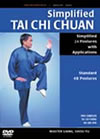
Simplified 24 Form: Bibliography, links, quotes, notes,
list of movements.
Simplified 24 Form Tai Chi.
VCD - 2discs. In English and Chinese. 41 minutes.
Sports
for All: 24 Forms T'ai Chi Ch'uan.
Standard Simplified Taijiquan 24 Form.
Research by Michael P. Garofalo, M.S. Yang Style of Tai Chi Chuan,
24 movements. This webpage includes a detailed bibliography of
books, media, links, online videos, articles, and resources. It provides a list of
the 24 movement names in English, Chinese, French, German and Spanish, with
citations for sources of the movement names. It provides detailed descriptions of each movement with
black and white line
illustrations and photographs. It includes relevant quotations, notes, performance times,
section breakdowns, basic Tai Chi principles, and strategies for learning the
form. The Peking (Bejing) Chinese National orthodox standard simplified 24 movement Tai Chi
form, created in 1956, is the most popular form practiced all around the world. Published by
Green Way Research, Valley Spirit Taijiquan, Red Bluff, California:
Webpage URL:
http://www.egreenway.com/taichichuan/short.htm.
Standard Simplified 24 Tai Chi Form, Names of Movements 1-24, 1 Page, PDF
Format, 11Kb By Michael P. Garofalo.
Standing Qigong, Standing Post
Meditations, Standing Energy, Embrace the One, Sink, Become Empty
Sung - Relaxation Bibliography, links,
quotes, and notes.
Sun Lu Tang's
Internal Martial Arts: Baguazhang, Xingyiquan, Taijiquan, and Qigong.
Bibliography, Links, Quotes, Resources, Instructions.
Sun Style of T'ai Chi
Ch'uan: Standard Competition 73 Movements Form. Research by
Michael P. Garofalo, M.S.. Webpage: 450Kb, June 2008. This webpage
includes an introduction, information on the history of the Sun Taijiquan forms, a
detailed bibliography, extensive links, references to video resources, a large
collections of quotations about Sun Taijiquan, recommendations on the best media
resources on the topic, and suggestions for learning the
73 competition Sun Taijiquan form. A detailed comparative list of the names of each
of the 73 movements is
provided, with
source references, and the movement names are given in English, Chinese,
Chinese characters, French, German, and Spanish. This webpage includes detailed
descriptions of each of the 73 movements with black and
white illustrations for each movement sequence along with
commentary and comparisons. Many additional nomenclature lists and section
study charts in the PDF format, photographs and graphics are also provided -
over 1.3 MB of information. This webpage is the most detailed
and complete document on the subject of the Sun Taijiquan Competition 73 Form
available on the Internet. This document was published by Green Way
Research, Valley Spirit Taijiquan, Red Bluff, California, 2008. URL:
http://www.egreenway.com/taichichuan/sun73.htm.
Sword - Standard 32 Sword Form in the Yang Style
Sword - Classical Yang Style 55 Movement Sword Form
Tai Chi
Beginning: A Complete Workout Reference for Beginners. By Wen-Ching Wu
and Denise Breiter-Wu. Way of the Dragon, 1998. 128 pages.
ISBN: 1889659037.
The
Tai Chi Book: Beginning and Enjoying a Lifetime of Practice.
By
Robert Chuckrow, Ph.D..
Tai Chi Cane and Short Staff, Yang Style
Tai Chi -
Chinese National 24 Form Taiji
Ottowa Chinese Martial
Arts. Illustrations
for all 24 postures of the 24 Form.
Tai Chi Chuan
By Marshall Ho'o. Burbank,
California, Ohara Publications,
Inc., 1986. 111 pages. Black Belt Magazine Publication. ISBN: 0897501098. The Taijiquan
explained and illustrated (with mediocre and grainy black and white photographs) is
the Standard 24 Form of
Taijiquan in the Yang Style. VSCL. Master Ho'o taught
this form on KCET public television in Los Angeles starting in 1973 and provided
me with my first exposure to T'ai Chi Ch'uan.
Tai Chi Chuan: The 27 forms by Marshall Ho'o. Instructional DVD,
released in 2005, featuring the late Marshall Ho'o.
Black Belt Videos, 90 minutes. Includes the Nine Temple Qigong.
Filmed in the 1980's.
Master Marshall Ho'o is also known for his Nine Temple Qigong Exercises.
This book (1986) by Master Marshall Ho'o is the first English language publication about the Standard 24 Taijiquan Form.
"Dr. Ho'o was instrumental in the certification of
acupuncture in the State of California. He was the first Tai Chi Master to have
been elected to the Black Belt Hall of Fame. He was Dean of the Aspen Academy of
Martial & Healing Arts, on the faculty of California Institute of the Arts, and
taught Tai Chi and Acupressure at many educational institutions. In 1973,
he created a series for KCET public television, in Los Angeles, teaching Tai Chi. He
was a consultant to Prevention Magazine's The Doctor's Book of Home Remedies.
A Chinese American, Dr. Ho'o was America's first T'ai Chi Ch'uan Grandmaster.
His influence is far-reaching in both the fields of healing and martial arts."
- The Lineage, Teachers
of Two Birds Tai Chi
T'ai Chi
Ch'uan and Qigong: Techniques and Training. By Wolfgang Metzger,
Peifang Zhou,
and Manfred Grosser. New York, Sterling Publishing Company, 1996.
Index, 144 pages.
ISBN: 0806959576. Includes a detailed description of the Beijing 24
movement form, pp. 86 -141. Excellent list and movement chart.
T'ai Chi Ch'uan: Beijing Short Form. Yang Style,
Standard Simplified Version, 24 Movements, Created in 1956. List of movements, notes, bibliography,
links, and photographs. Peking short form Taijiquan. By
Michael P. Garofalo.
300Kb HTML file:
http://www.egreenway.com/taichichuan/short.htm
Tai Chi Chuan Sports. Edited by the People's Republic of China Physical
Education Committee. Beijing, China, 1996. ISBN: 7500911505.
Tai Chi Chuan, Standard Simplified Beijing 24 Form, Names of Movements 1-24, 1 Page, PDF
Format, 11Kb By Michael P. Garofalo.
Version II.
Tai Chi Chuan Classical Yang Style: The Complete Form and Qigong. By
Dr. Yang, Jwing-Ming. Boston, MA, 2010. 396 pages. ISBN:
978-1594392009. "Awards: Gold Winner, 2011 IP's Living Now Awards; Gold
Winner, 2011 eLit Award, Finalist - 2011 Eric Hoffer Award, Finalist - 2011 USA
Best Book Award. Taijiquan is a slow and relaxed moving meditation.
It is also a sophisticated martial arts system. Through practicing
Taijiquan, you are able to calm down the mind, locate your spiritual center, and
consequently find your entire being. From the relaxed moving exercise, you
can bring your physical body into an ultimate level of relaxation and natural
ease, resulting in smooth Qi (inner energy) and blood circulation. This is a key
to maintaining health and recovering from sickness. This book is an
in-depth guide for beginners to learn Taijiquan properly. It offers a
general plan for practicing Taijiquan, and then goes into great depth to present
enough content for proper learning.
Dr. Yang, Jwing-Ming is a world authority on Tai Chi Chuan and Chinese martial
arts. He maintains 55 schools in 18 countries. He is the author of
over 35 books and 80 instructional videos, nominated as a person 'who has made
the greatest impact on martial arts in the past 100 years' — Inside Kung Fu
Magazine (1999). Dr. Yang, Jwing-Ming resides and teaches at his
retreat center in Miranda, California." VSCL.
Tai Chi
Chuan in 24 Forms. By Donald McPherson and Phyboon Cheng.
Presented in English and Chinese. Lulu.com, 2006. 160 pages.
ISBN: 1411677242.
T'ai Chi
Ch'uan Martial Applications Advanced Yang Style. By Dr. Wang, Jwing
Ming. Edited by Alan Doughall. Jamaica Plain, MA, YMAA Publications, 2nd
Edition,
1996. 363 pages. ISBN: 1886969442.
VSLC.
T'ai Chi Ch'uan
Movements Illustrated Photographs of
Gao
Jiamin.
Tai Chi
Chuan: The Chinese Way. By Foen Tjoeng Lie. New York, Sterling
Publishing
Co., 1988. 126 pages, black and white illustrations, index.
ISBN: 0806968265. Excellent photos of Mr. Lie doing the form, informative descriptions, and a good
introduction. VSCL.
T'ai Chi Ch'uan: 24 And 48 Postures With Martial Applications. By Master Liang, Shou-Yu and Wu, Wen-Ching; and, edited by Denise Brieter. Boston, YMAA Publications. 2nd Edition, 1993, 1996. ISBN: 1886969337. Index, bibliography, glossary, 153 pages. In my opinion, this is the best book to purchase when learning the Beijing 24 Short Form. Detailed instructions, excellent photographs, and extensive martial applications make this a first choice for students. "An extraordinary guide to Taijiquan (Tai Chi Chuan), the "Grand Ultimate" way of health and martial arts. Written by one of China’s top-ranked coaches (Liang), the 24 and 48 postures, often referred to as the Short Form, are presented in an easy to understand, step-by-step fashion. Also included are guidelines for breathing, directing the mind, aligning the body and developing Qi (Chi). Learn how the practice of Taijiquan can improve health. Discover martial applications for each posture that will make your learning more authentic and alive. Gain deeper insight with the explanations and illustrations of the philosophy of Yin-Yang and the Five Elements Theory. A practical learning tool for beginners, and an excellent reference guide for more advanced students." VSCL.
Tai
Chi Ch'uan 24 Forms for Curious Learners. By Andy Ma and Howard
Rosenberg.
Paperback or eBook formats.
Study Yang Style Taijiquan with Mike Garofalo in Red Bluff, California
Tai Chi Connections: Advancing Your Tai Chi Experience. By John Loupos. Boston, MA, YMAA Publication Center, 2005. Index, 194 pages. ISBN: 1594390320. VSCL. All three books by John Loupos are very useful.
Tai Chi Essentials: The Simplified 24 Form. By Andrew Townsend. Create Space Independent Publishing, 2015. 320
pages. ISBN: 978-1514250488. VSCL.
Tai Chi for
Beginners: The 24 Forms. By Lin Williams. Instructional
videotape.
DVD: MBSDVD009.
Tai Chi for Beginners and the 24 Forms. By Dr. Paul Lam and Nancy Kaye. Balmain, NSW, Limelight Press, 2006. Index, references, 207 pages. ISBN: 0977536114. "Beautifully illustrated with 330 professional photos to enhance the easy to follow Tai Chi instruction from world renowned Tai Chi Master and Family Physician, Dr. Paul Lam.. Beginning with Six Easy Steps and progressing to Yang 24 Forms ( the world's most popular tai chi form ), Dr Lam teaches authentic Tai Chi for health, wellness and longevity. He explains how tai chi improves health in general as well as specific conditions. Encouraging the reader to approach Tai Chi in a spirit of enjoyment and adventure, Dr. Lam helps the reader build a solid foundation for easy transition to a high level of tai chi. This book is for beginners as well as for those who are already learning and enjoying the ancient art which is clinically proven to be a powerfully effective tool in improving health, fitness and relaxation. Within this book, Dr. Lam provides an easy step-by-step guide to an enjoyable form of exercise that will last a life time." VSCL.
Tai Chi: The 24 Forms. By Dr. Paul Lam. Instructional DVD, 240
Minutes, 2009. ASIN: 0987105108. NTSC Format. VSCL.
Tai Chi for Body, Mind and Spirit: A Step-by-Step Guide to Achieving
Physical and
Mental Balance. By Eric Chaline. New York, Sterling Publishing
Co., 1998. $14.95.
Index, 127
pages. ISBN: 0806963212. Detailed Instructions and color photographs
for the
24 movement standard short form. Includes some qigong exercises. VSCL.
Tai Chi for Health
By Tai-Chi-Xin. See Also:
Tai
Chi 24 Forms
Tai Chi for Health: The 24 Simplified Forms.
By Cheng Zhao and Dan Zhao. Indiana, Agilceed Books, 2006. 163 pages. ISBN:
0976118319. There is also an instructional DVD to accompany this book by
Cheng Zhao and Don Zhao. Overview of 4 Form, detailed descriptions of each
movement, general principles, questions and answers, flow charts. Hundreds
of black and white photographs, illustrations, artwork, and graphics. This
is a much better book than the 32 Sword Form book by the same authors. Dr.
Cheng Zhao is a full professor at Indiana State University. VSCL.
Tai Chi for Life: Yang Style Tai Chi. By Guangzhi Xing. 24 Form
Simplified Tai Chi, Tai Chi Sword 32 Form. Instructional DVD, 90 minutes,
Color. Turtle Press, 2002.
Instruction in English.
Tai Chi
for Seniors: How to Gain Flexibility, Strength, and Inner Peace.
By Philip Bonifonte. New Page Books, 2004. 216 pages. ISBN:
1564146979.
The 24 form is taught.
Tai Chi for Small Space. By Jiang Jian-ye. Based on the
24-form simplified T'ai
Chi from in the Yang style. 120 minute videotape. Jiang's
Tai Chi Videos.
Tai Chi
for Staying Young: The Gentle Way to Health and Well-Being. By Lam
Kam-Chuen. Fireside, 2004. 128 pages. ISBN: 0743255046.
Tai
Chi: Health for Life. How and Why It Works for Health, Stress Relief,
and Longevity. By Bruce Frantzis. Berkeley, California, Blue Snake Books, Energy Arts
Inc., c 2006. Index, 320 pages. ISBN: 1583941444.
VSCL.
Tai Chi is for Everyone, Illustrated and Full Colour: Build Strength and Stamina, Calm Body and Mind, Release Toxins and Relieve Stress
By Petra Ortiz. CreateSpace Independent Pub., 2015. 112 pages.
ISBN: 978-1514854631.
Tai Chi
Productions Newsletter Edited by Master Paul Lam, M.D. He
has produced
an excellent instructional videotape/DVD on the 24 Form.
Tai Chi Qi Gong. By Jiang Jian-ye. 117 minute videotape.
24 movement form is taught along with some qi gong applications.
Jiang's
Tai Chi Videos.
Tai Chi
Secrets of the Yang Style. Translated with commentary by Dr. Yang, Jwing-Ming.
Translations and commentary on Chinese Classics. Boston, MA, YMAA
Publications, 2001. Index, glossary, 192 pages. ISBN:
1886969094.
A translation of 49 documents by Yang, Ban-Hou (1837-1892) and by a
few other Yang family members. VSCL.
Tai
Chi: 6 Forms, 6 Easy Lessons. By Dr. Paul Lam. VHS
and DVD. Wellspring
Media, 1995, 1998. ASIN: 1885538715. An earlier version
of Tai Chi: The 24 Forms.
Tai Chi: The 24 Forms. By Dr. Paul Lam. A 120 minute videotape that
teaches the Simplified 24 Form, Beijing 1956 version, Yang style T'ai Chi Ch'uan. This
excellent
instructional videotape/DVD includes warm up exercises, 6 qigong exercises,
7 movement drills,
and extensive and clear step by step instructions and numerous multi-angle demonstrations
of the 24 postures in this popular short form. Dr. Lam,
a family physician in Australia, has won gold
medals in international Taiji competitions, and has published many good books, newsletters, articles, and produced many fine Taiji instructional
videotapes. VHS videotape (ISBN:1583500197) and DVD version (ISBN: 1583501088). $30.00. Produced by WellSpring Media,
1999.
Reviews VSCL.
Tai-Chi
24 Form. By Robert Yeoh. 14 pages, PDF format.
Detailed written instructions
for each of the 24 postures of the form. Excellent resource.
Tai Chi 24 Form - Amazon Books
Tai Chi
24 Form, Names of Movements 1-24, 1 Page, PDF Format, 11Kb
Tai Chi 24 Forms
By Tai-Chi-Xin. See Also
Tai
Chi for Health
Tai Chi
Secrets of the Yang Style. Translated with commentary by Yang
Jwing-ming.
Translations and commentary on Chinese Classics. Boston, MA, YMAA
Publications, 2001. Index, glossary, 192 pages. ISBN:
1886969094.
A translation of 49 documents by Yang, Ban-Hou (1837-1892) and by a
few other Yang family members. VSCL.
Tai Chi
Theory and Martial Power: Advanced Yang Style Tai Chi. By Dr. Yang,
Jwing-Ming.
Jamaica Plain, Mass., YMAA Publication Center, 1996. Second Edition.
Glossary, index, 268 pages. ISBN: 1886969434. VSCL.
Tai Chi
Touchstones: Yang Family Secret Transmissions. Compiled and translated
by Douglas Wile. Brooklyn, New York, Sweet Chi Press, 8th Edition, 1983. 159
pages.
ISBN: 091205901X. VSCL.
Tai-Chi-Xin. See Also:
Tai
Chi 24 Forms and
Tai Chi
for Health
Tai Chi: Yang Family Basic 24 Forms. By Li Huilin. Beijing, China,
Da Lian Audio and Visual Publishing House, 2005. ISRC
CN-D03-05-0061-0/V-J7. Book and DVD.
Taijiquan,
Classical Yang Style: The Complete Form and Qigong. By Dr. Yang, Jwing-Ming. Boston, MA, YMAA Publications Center, 1999. Index,
glossary,
333 pages, 562 illustrations.
ISBN:188696968X. There is also an instructional
videotape
and DVD to
supplement this book. The DVD contains the complete form, gigong, details instructions for each
movement, and 13 postures. Performed by Dr. Yang, Jwing-Ming and Robert Was. 240 Minutes, DVD9-NTSC, 2003. DVD ISBN: 0940871645.
VSCL. See Also: Tai Chi Chuan Classical Yang Style: The
Complete Form and Qigong 2010.
The
Taijiquan Classics: An Annotated Translation. By Barbara Davis.
Includes a commentary by Chen Wei-ming. San Franscisco, North Atlantic Books, 2004. Index, bibliography, notes, 200 pages. ISBN:
1556434316. VSCL.
Taijiquan: Cultivating Inner Strength
By C. P. Ong. Bagua Press, 2013. 366 pages. ISBN:
978-0615874074. VSCL.
Taijiquan Classics Bibliography,
links, quotes, notes.
Taiji Quan in 24 Forms.
Series of Chinese Wu Shu Shows: 24 Forms In Situ Taiji Quan -Teaching Choice.
Presentation and performance by Master Hu Qixian. Production by Sports
Audio-visual Publication, Beijing. 1 NTSC videotape in Chinese.
Taijiquan Theory of Dr. Yang, Jwing-Ming: The Root of Taijiquan. By Yang Jwing-Ming.
Boston, Massachusetts, 2003. References, glossary, index, 270 pages.
ISBN: 0940871432.
Taijiquan 24 Form, Names of Movements, Movements 1-24, 1 Page, PDF Format,
10Kb
Taiji
24 Form. Professor Le Din Yin. DVD
Taiji 24 Form: Part 1 of 8. Instructions by Kelly MacLean.
Movements 1, 2 and 3 explained with color photographs.
Taiji 24 Form
Detailed instructions and scores of photographs. One of the best
on-line
instructional resources for the 24 Form. the 24 Form is divided into 8
sections/webpages for
instructional purposes. Kelly Maclean is a full time instructor, and has
taught
Taiji and Wushu with Shou-Yu Liang Wushu Taiji Qigong Institute for many
years. Produced by the WushuTaiji Qigong Intstitute.
Taiji 24 Form, Standard Simplified 24 Taijiquan Form, Names of Movements 1-24, 1 Page, PDF
Format, 11Kb By Michael P. Garofalo.
Tao Te Ching
(Daodejing) by Lao Tzu (Laozi) Compiled and indexed by Mike
Garofalo.
Teach
Yourself Tai Chi. By Robert Parry. McGraw Hill, 3rd Edition,
2007. 192 pages. ISBN: 0071490922.
Total
Tai Chi: The Step-by-Step Guide to T'ai Chi at Home for Everybody. By
Ronnie Robinson. Duncan Baird, 2006. 144 pages. ISBN:
1844832627.
Thirteen Postures of Taijiquan.
Bibliography, links, notes, charts, quotes. 8 Gates and 5 Steps of T'ai Chi Ch'uan.
32 Standard Sword (Jian)
Form - Yang Style Bibliography, Links, Quotes, Notes.
Traditional Chen Style Taijiquan
Traditional Yang
Family Short Form. By Howard Choy. A 39 movement short
form.
Traditional Yang
Style Tai Chi Chuan 103 Movement Hand Form - Movement Names
24 Form Denotations and
Photographs
Study Yang Style Taijiquan with Mike Garofalo in Red Bluff, California
24 Form (Simplified Form) T'ai Chi Ch'uan - Wikipedia
24 Form, Standard Simplified 24 Taijiquan Form, Names of Movements 1-24, 1 Page, PDF
Format, 11Kb
24 Forms Tai Chi Chuan.
Demonstration and instruction by Wu A. Ming. 2 instructional DVDs and
booklet.
24 Forms Tai Chi Chuan Simplified.
Instruction and demonstration by Master Jiang Jian-ye. Instructional
DVD or VHS videotape, 120 minutes. "This video teaches the standardized
24-movement form based on the Yang style that has been popularized in China.
Jiang demonstrates the form and then teaches it step by step. Each form is
taught with multiple views and repetitions. There are reviews of segments and
the form is demonstrated multiple times at the end, front and rear."
Available from Wayfarer
Publications Catalog.
24
Movement Taijiquan 太極拳 Form and Applications. Master Shouyu Liang and
Sam Masich. Instructional DVD.
Video
preview.
24 Posture Tai Chi
(Erishisishi Tajiquan) List of postures in English and Chinese.
Includes black and white illustrations of the postures arranged in an S shaped
flowing layout.

The 24 Simplified Forms of Tai Chi Chuan. By Li Deyin. Beijing,
China, The Audio and Video Publishing House of Beijing TV Art Center, 2005.
ISRC CN-C07-02-318-00/V.G4.
24 Standard Simplified 24 Taijiquan Form. 300Kb.
Twenty Four Forms Tai Chi Simplified-Enhanced. By Jiang
Jian-ye. A 90 minute videotape that teaches the standard Yang style, Beijing version, short form of Tai Chi
Chuan. Jiang's Tai Chi Videos.
Valley Spirit Center, Red
Bluff, California
Valley Spirit
Taijiquan: Practice Assignments for Beginners Learning the 24 Form
VSCL = Valley Spirit Center
Library, Red Bluff, California. Personal collection of Mike Garofalo.
The Way
of Harmony By Howard Reid. A guide to self-knowledge
through the Arts of Tai
Chi Chuan, Hsing I, Pa Kua, and Chi Kung. London, Gaia Books Limited,
1988. Index,
191 pages. ISBN: 0671666320. Instructions and illustrations of
the Short 24 Form can
be found on pages 90 - 139.
VSCL.
The Way
of Qigong: The Art and Science of Chinese Energy Healing. By Kenneth
S. Cohen.
Foreword by Larry Dossey. New York Ballantine Books, 1997. Index,
notes, appendices, 427 pages. ISBN: 0345421094. One of my favorite books:
comprehensive, informative, practical, and scientific. VSCL.
Way of the Short
Staff. By Michael P. Garofalo, M.S. A comprehensive guide to the
practice of the short staff, cane, jo, walking stick, gun, zhang,
whip staff, 13 Hands Staff, and related wood short staff weapons. A
detailed and annotated guide, bibliography, lists of links, resources,
instructional media, online videos, and lessons.
Includes use of the short staff and cane in martial arts, self-defense, walking
and hiking. Separate sections on Aikido Jo, Cane, Taijiquan cane and
staff, Jodo, exercises with a short staff, selected quotations, techniques,
selecting and purchasing a short staff, tips and suggestions, and a long section
on the lore, legends, and magick of the short staff. Includes "Shifu
Miao Zhang Points the Way." Published by Green Way Research,
Valley Spirit Taijiquan,
Red Bluff, California. Updated on a regular basis since October, 2008. Filesize: 275 Kb. Related to Mike's popular webpage on the
Staff.
Wild Goose (Dayan) Qigong: Bibliography, Links, Resources,
Quotes, Notes.
Yang Family Style Tai Chi Chuan Traditional Long Form,
108
Movements. By Michael P. Garofalo. 100 Kb+ Provides a list of the movements divided into five sections for teaching (.html and .doc versions available).
Includes a bibliography, links, notes, and quotations. Provides a list comparing the Yang
Long Form
108 to 85 postures sequence.
Yang Modified 24 Postures Short Form. Lots of line drawings for each of the postures in the 24 form. 27Kb. Mirror
Yang
Modified 24 Postures Short Form.
Line drawings, names.
Yang
Short Form 27Kb. F. Wysoki.
Yang Short Form
Pictorial A long sequence of color photographs of students
performing the short form in a park. From Dragon Studios.
Yang
Style Short Form 24 Beijing Style A list of the 24
movements in this form.
Yang Style Short Form A list of the 24 movements in
this form.
Yang Style Short Form, 24 Form. A list of the 24 movements in this
popular form.
Yang Style Short Form Tai Chi. Written by David Hann. Detailed
narrative about performing the 24 Form. 54Kb.
Yang
Style Tai Chi Chuan and Its Applications. By Yang,
Jwing-Ming. VHS videotape.
Boston, YMAA Publications, 1995. ASIN: 0940871181.
Applications for postures
in the 24, 48 and 108 forms.
Yang Style Taijiquan Short Form, Peking Version 24
Movements.
Yang Style Taijiquan Long Form 108 Movements
The
Yang Taiji 24-Step Short Form: a Step-by-Step Guide for all Levels. By
James Drewe. London and Philadelphia, Singing Dragon, 2011. 382
pages. ISBN: 9781848190412. VSCL.
Yang Tai Chi 24 Form Self Defense
By Sifu Ken Gullette. Internal Fighting Arts, 2013. 199 pages.
E-book Kindle Format. "This book contains 259 photos and 108
self-defense techniques for the most popular Tai Chi form in the world -- the
Simplified Yang Tai Chi 24 Form. It is practiced by millions of people each day.
Most of these people know the meditative aspects of Tai Chi as taught for health
and mental balance. This ebook will take you deeper into the art by showing you
how each movement is performed for self-defense. Sifu Ken Gullette won a
National Championship with the Yang 24 Form at the 1990 AAU Kung Fu National
Championships. He practiced and taught the form for many years and was not only
fascinated by the physical and mental benefits of Tai Chi, but he was also
fascinated at the way self-defense techniques were hidden in the movements. Tai
Chi was designed to be a powerful martial art. The founder of Yang Tai Chi, Yang
Luchan, learned the art from the Chen family in the Chen Village, Henan
Province, China. He left to go to Beijing, where he developed his style of Tai
Chi -- Yang style -- and became teacher to the Imperial family. Ken has also
learned from members of the Chen family and their American students. Over time,
especially as Tai Chi became more popular with the elderly, and as it was
introduced to America, the self-defense aspects were virtually lost. In this
book, Ken shows you that there are no transitions in Tai Chi. Every movement, no
matter where your hands are, is a self-defense move. You'll learn deflections,
blocks, hand strikes, kicks, joint locks (qinna), sweeps and takedowns, all
inside the movements of the Yang 24 form. Tai Chi is performed slowly for
health, and to develop the body mechanics needed for relaxed power. For
self-defense, you develop the ability to perform the movements with bursts of
power that make it a fantastic art for self-defense. This book will unlock the
meaning behind the movements." VSCL.
Return to the Main Index for this Webpage
Video Resources Online
Standard Simplified National T'ai
Chi Ch'uan 24 Form, Yang Style
I prepared this list many years ago, and some of the links might no longer be active. UTube has expanded greatly over the past few years. There may now, in 2015, be many more good examples of performances or instructions about the 24 Taijiquan Form online on UTube and elsewhere.
Tai Chi, 24 Yang Form, M
Du Feu, UTube 2007, 6:18 min.
Les 24 Mouvements du Style Yang (Vinz - 24 Yang Style Taijiquan),
Google Video, 1006, 7:21 min.
Yang Tai Chi National 24 Forms, Narration in Chinese, UTube, 2006. 4:37 min.
A young woman doing a graceful performance.
Mirror
Tai Chi
Chuan Yang. Google Video, 2006, 4:13 min. Very good and strong
performance by a young woman.
Tai Chi Chuan - Yang -
Forma 24 movimentos. UTube Video, 2007, 3:40 min. A young man
performing in a courtyard.
Tai Chi Chuan Yang
Simplified. Utube Video, 2007, 5:47 min. A young woman, Rie
Takahashi, performs the form.
Tai Chi Form 24 Form.
UTube Video, 2006, 7:19 min. Master Jesse Tsao performs.
Yang Tai
Chi National 24 Form. Video - Google, 4:37. Graceful young
lady in a pink Tai Chi uniform.
Yang Taijiquan 24 Form.
UTube Video, 2006, 5:51 min. A young woman performs the form.
Tai Chi 24 Forms.
UTube Video, 6:25. Performed by Paul Lam, M.D..
Search UTube:
Tai
Chi Chuan Yang 24
Return to the Main Index for this Webpage
List
of Movements
National Standard T'ai Chi Ch'uan 24 Short Form
Standard Simplified Version, 24 Movements, 1956, Yang Style Taijiquan
Standard Simplified 24 Tai Chi Form, Names of Movements 1-24, 1 Page, PDF
Format, 11Kb
Citations for Reference Sources for Movement Names
I welcome your suggestions on how to improve these translations into other languages for the names of the movements. Have others produced lists of the 24 Taijiquan Form movements in other languages? Send your contributions and suggestions to my email box. Thanks to Stephane Gervais from France, who on 6/8/09 sent me the improved translations into French.
1. Opening Posture of Taijiquan (Taijiquan Qi Shi)
Commencing (Qishi)
[Liang & Wu 1996]
Starting Posture [Zhang Fuxing 1996; Chong 1981]
The Beginning (Qi Ji) [Foen Tjoeng Lie 1988; Metzger & Zhou
1996]
Starting Form [Zhao 2006]
Standing Quietly, Raise and Lower Hands
Reconnecting with Oneness and Emptiness
Quiet Standing
Mediation: Zhan Zhuang, WuJi
Commencement
Taijiquan
Opening Movement
Opening Posture of Taijiquan [Garofalo 2008]
Ouverture
Öffnung Lage von Taijiquan
Postura de la Abertura de Taijiquan
预 备 : Yu Bei
: Preparation
Form
Explanations and Interpretations of the Opening Posture/Movement #1 of Taijiquan
2. Wild Horse Shakes Its Mane (Ye Ma Fen Zong)
Part the
Wild Horse's Mane (Yema Fenzong) [Liang & Wu]
Wild Horse Waves Its Mane [Zhang Fuxing]
Parting a Wild Horse's Mane (Zuo You Ye Ma Fen Zong) [Foen Tjoeng Lie]
Wild Horse Parts Its Mane [Chong]
Parting the Horse's Mane [Metzger & Zhou]
Wild Horse Splits Mane [Zhao]
Wild Horse Shakes Its Mane
Mustang Tosses Its Wild Mane
Left (左 : Zou) Part the Wild Horse's Mane (Zou Yema Fenzong)
Right (右 : You) Part the Wild Horse's Mane (You Yema Fenzong)
Wild Horse Shakes Its Mane [Garofalo]
Séparer la crinière du cheval. 3 fois
Wildes Pferd Rüttelt Seine Mähne
El Caballo Salvaje Sacudare Su Melena
野马分鬃 : Ye Ma Fen Zong : Parting
the Wild Horse's Mane
3. White Crane Spreads Its Wings (Bai E Liang Chi)
White Crane
Spreads Its Wings (Baihe Liangchi) [Liang & Wu, Zhang
Fuxing]
The Stork Spreading Its Wing (Bai Ne Liang Chi) [Foen Tjoeng
Lie]
Stork Spreading Its Wings [Metzger & Zhou]
White Crane Spreads Out Its Wing [Chong]
White Crane Shows Its Wings [Zhao]
White Stork Spreading Its Wings
White Crane Lifts Its Wings
White Stork Cools Its Wings
White Crane Spreads Its Wings [Garofalo]
La grue blanche étend ses ailes
Weißer Kran Verbreitet Seine Flügel
La Grúa Blanca Separa Sus Alas
白鵝亮翅 : Bai E Liang Chi
Brush Knee
and Step Forward (Louxi Aobu) [Liang & Wu]
Brush Knee and Twist Step [Zhang Fuxing]
Brush You Knee and Step (Zuo You Lu Xi Niu Bu) [Foen Tjoeng
Lie]
Brushing Your Knees and Stepping [Metzger & Zhou]
Brushing the Knees and Taking Zigzag Steps [Chong]
Brush Knee and Turn Steps [Zhao]
Twist Step, Brush Knee, Palm Strike
Brush Knee [Garofalo]
Avancer et brosser le genou. 3 fois.
Bürste Knie
Rodilla Del Cepillo
左搂膝拗步 : Lou Xi Ao Bu
: Brush Knee and Twist Step
5. Playing the Lute (Shou Hui Pi Pa)
Play the Lute (Shouhui
Pipa) [Liang
& Wu; Chong]
Play "Pipa" [Zhang Fuxing]
Playing the Lute (Shou Hui Pi Pa) [Foen Tjoeng Lie]
Playing the Pipa [Metzger & Zhou]
Hand-hold the Lute [Zhao]
Playing
the Guitar
Strumming the Lute
Playing the Pipa
Playing the Lute [Garofalo]
Jouer de la guitare (ou du luth)
Spielen des Dichtungskitts
Tocar el Laúd
手挥琵琶 : Shou Hui Pi Pa :
Hand Strums the Lute
6. Step Back and Repulse Monkey (Dao Nian Hou)
Reverse Reeling Forearm (Daojuan Gong)
[Liang & Wu]
Step
Back to Drive the Monkey Away [Zhang Fuxing; Chong]
Step Back and Swirl Your Arms (Zuio You Dao Jun Hong) [Foen
Tjoeng Lie]
Fending Off the Monkey [Metzger & Zhou]
Back-rolling the Forearms [Chong]
Repulse the Monkey [Zhao]
Repulse Monkey and Step Back
Step
Back and Drive Monkey Away
Step Back and Repulse Monkey [Garofalo]
Reculer et repousser le singe. 4 fois.
Schritt Rückseitig und Repulse-Affe
Paso Trasero y Mono de la Repulsión
倒撵猴 : Dao Nian Hou
7. Grasping the Sparrow's Tail - Left (Zuo Lan Que Wei)
Left-Grasp the Sparrow's Tail (Zuolan Quewei)
[Liang & Wu]
Grasp the Bird's Tail on the Left
[Zhang
Fuxing]
Grasping the Sparrow's Tail - Left (Zuo Lan Qiao Wei) [Foen
Tjoeng Lie: Metzger & Zhou]
Grasping the Bird's Tail, Left Mode [Chong]
Left Grasp the Peacock's Tail [Zhao]
Grasp the
Sparrow's Tail to Left Side
Grasping the Peacock's Tail to Left
Four
Gates
Grasp the
Sparrow's Tail to the Left Side (Zuo Lan Qiaowei)
Grasping the Sparrow's Tail - Left [Garofalo]
Saisir la queue de l'oiseau à gauche.
Fassen der Endstück-linken Seite des Spatzen
Agarrar el Llado Izquierdo de la Cola del Gorrión
拦雀尾左 : Lan Que Wei Zou
: Grasp the Bird's Tail Left
8. Grasping the Sparrow's Tail - Right (You Lan Que Wei)
Right-Grasp the Sparrow's Tail (Youlan Quewei)
[Liang & Wu]
Grasp the Bird's Tail on the Right [Zhang Fuxing]
Grasping the Sparrow's Tail - Right (You Lan Qiao Wei) [Foen
Tjoeng Lie; Metzger & Zhou]
Grasping the Bird's Tail, Left Mode [Chong]
Right Grasp the Peacock's Tail [Zhao]
Grasp the
Sparrow's Tail to the Right Side
Grasping the Peacock's Tail to Right
Grasp the Bird's Tail to Right
Four
Gates
Grasp the
Sparrow's Tail to the Right Side (You Lan Qiaowei)
Grasping the Sparrow's Tail - Right [Garofalo]
Saisir la queue de l'oiseau à droite.
Fassen der Endstück-rechten Seite des
Spatzen
Agarrar el Derecho de la Cola del
Gorrión
拦雀尾右
: Lan Que Wei You : Grasp the Bird's
Tail Right
Single Whip (Danbian)
[Liang & Wu]
Single Whip [Zhang Fuxing, Zhao]
The Whip (Dan Bian) [Foen Tjoeng Lie]
Simple Whip
[Metzger & Zhou]
Holding a Single Whip [Chong]
Single Whip [Garofalo]
Simple fouet.
Single Peitsche
Escoja El Azote
单鞭 : Dan Bian
10. Waving Hands Like Clouds (Yun Shou)
Wave Hands Like Clouds
(Yunshou)
[Liang & Wu]
Wave Hands Like Clouds
[Zhang Fuxing, Zhao]
Move Hands Like Clouds (Yun Shou)
[Foen Tjoeng Lie]
Moving Hands Like Clouds [Metzger & Zhou]
Waving Hands Like Clouds Drifting By [Chong]
Waving
Hands Like Clouds
Cloud Built Hands
Wave Hands in Clouds
Waving Hands Like Clouds [Garofalo]
Agiter les mains comme des nuages. 3 fois.
Wellenartig Bewegende Hände Mögen Wolken
Las Manos Que Agitan Tienen Gusto De las Nubes
云手 : Yun Shou
Study Yang Style Taijiquan with Mike Garofalo in Red Bluff, California
Single Whip (Danbian)
[Liang & Wu, Zhang
Fuxing]
The Whip (Dan Bian) [Foen Tjoeng Lie, Zhao]
Simple Whip
[Metzger & Zhou]
Holding a Single Whip [Chong]
Single Whip [Garofalo]
Simple fouet.
Single Peitsche
Escoja El Azote
单鞭 : Dan Bian
12. Pat the Horse on the Back (Gao Tan Ma)
High Pat on Horse (Gaotan
Ma)
[Liang & Wu]
Stroke the Horse From Above
[Zhang Fuxing]
Asking for Directions While Riding a Horse (Gao Tan Ma) [Foen
Tjoeng Lie]
Patting the
Horse's Neck While Riding
[Metzger & Zhou]
Patting the Horse on the Back [Chong]
High Hand Pats the Horse [Zhao]
Pat the Horse on the Back [Garofalo]
Tall Scout Horse, Mounted Scout [John
Warriner]
Caresser la crinière du cheval (ou Flatter l'encolure du cheval)
Tappen Sie das Pferd auf der Rückseite
Acaricie al Caballo en la Parte Posteriora
高探马 : Gao Tan Ma : High Pat
on Horse
13. Kick with Right Heel (You Deng Jiao)
Right Heel Kick (You Dengjiao)
[Liang & Wu]
Kick with Right Heel
[Zhang Fuxing, Zhao]
Right Heel Kick
(You Deng Jiao)
[Foen Tjoeng
Lie; Metzger & Zhou]
Kicking Straight, Right Mode [Chong]
Kick with Right Heel [Garofalo]
Coup-de-pied Avec le Talon Droit
Stoß mit der Rechten Ferse
Retroceso con el Talón Derecho
右蹬脚 : You Deng Jiao :
Right Heel Kick
14. Hitting Your Opponent's Ears with Both Fists (Shuang Feng Quan Er)
Strike to Ears with Both
Fists (Shuangfeng Guaner)
[Liang & Wu]
Hit the Opponent's Ears with Both Fists [Zhang Fuxing]
Hit Your Opponent's Ears with Both Fists (Shuang Feng Guan Er)
[Foen Tjoeng Lie; Metzger & Zhou]
Striking the Opponent's Ears with Both Fists [Chong]
Strike Ears with Both Fists
[Zhao]
Box Opponent's Ears with Both
Fists
Box Ears with Both Fists
[Garofalo]
Hitting Your Opponents Ears with Both
Fists
Frapper les oreilles du tigre (ou frapper aux 2 oreilles).
Schlagen Ihrer Konkurrenten Ohren mit beiden Fäusten
Golpear sus Oídos de los Opositores con Ambos Puños
双峰灌耳 : Shuang Feng Quan Er :
Twin Fists Strike Opponents Ears
15. Kick with Left Heel (Zuo Deng Jiao)
Turn Body and Left Heel Kick (Zhuanshen
Zuo Dengjiao)
[Liang & Wu]
Turn Round and Kick with Left Heel [Zhang Fuxing]
Left Heel Kick (Zhuan Shen Zuo Deng Jiao) [Foen Tjoeng Lie;
Metzger & Zhou]
Kicking Straight, Left Mode [Chong]
Kick with Left Heel [Zhao]
Kick with Left Heel [Garofalo]
Tourner vers la gauche et donner un coup de talon gauche
Stoß mit der Linken Ferse
Retroceso con el Talón Izquierdo
左蹬脚 : Zuo Deng Jiao : Left Heel Kick
16. Snake Creeps Down, Golden Rooster Stands on Left Leg (Xia Shi, Jin Ji Du Li)
Left Lower Body Then Stand
on One Leg (Zuo Xiashi Duli)
[Liang & Wu]
Squat Down and Stand on Left Leg
[Zhang Fuxing]
Climb Down and Stand on Your Left Leg (Zuo Xia Shi Du Li) [Foen
Tjoeng Lie]
Stooping Down and Then Standing on One Leg, Left Mode [Chong]
Squat Down on Right Leg,
Snake
Creeps Down Left Leg, Stand on One Leg
Crooked Whip Left
[Metzger & Zhou]
Left Down One-leg Stand [Zhao]
Squat on Right, Climb Down
Left
Golden Rooster Stands on Left Leg
Snake Creeps Down, Golden Rooster Stands on Left Leg [Garofalo]
Snake Creeps Down
Le serpent qui rampe à gauche.
Die Schlange Kriecht Unten
La Serpiente Se Arastra Abajo
Golden Rooster Stands on One Leg
Coq d'or sur une patte.
Der Goldene Hahn Steht auf einem Bein
El Gallo de Oro Está Parado en Una Pierna
下势 : Xia Shi : Snake Creeps
Down
左金鸡独立 : Zuo Jin Ji Du Li : Golden Rooster Stands
on Left Leg
17. Snake Creeps Down, Golden Rooster Stands on Right Leg (Xia Shi, Jin Ji Dui Li)
Right Lower Body Then
Stand on One Leg (You Xiashi Duli)
[Liang & Wu]
Squat Down and Stand on Right Leg [Zhang Fuxing]
Climb Down and Stand on Your Right Leg (You Xia Shi Du Li) [Foen
Tjoeng Lie]
Stooping Down and Then Standing on One Leg, Right Mode [Chong]
Right Down One-leg Stand [Zhao]
Crooked Whip Right [Metzger & Zhou]
Squat Down on Left Leg
Snake
Creeps Down Right Leg
Squat on Left, Climb Down
Right
Golden Rooster Stands on Right Leg
Snake Creeps Down, Golden Rooster Stands on Left Leg [Garofalo]
Snake Creeps Down
Le serpent qui rampe à droite.
Die Schlange Kriecht Unten
La Serpiente Se Arastra Abajo
Golden Rooster Stands on One
Leg
Coq d'or sur une patte.
Der Goldene Hahn Steht auf einem Bein
El Gallo de Oro Está Parado en Una Pierna
下势 : Xia Shi : Snake Creeps
Down
右金鸡独立 : You Jin Ji Du Li : Golden Rooster Stands
on Right Leg
18. Fair Lady Works the Shuttles (Yu Nu Chaun Suo)
Shuttle Back and Forth
(Chuansuo)
[Liang & Wu]
Fair Lady Works with Shuttles
[Zhang Fuxing]
Throwing the Loom (Left and Right) (Zuo You Chuan Zuo) [Foen
Tjoeng Lie; Metzger & Zhou]
Shuttling Between Left and Right, Fair Lady Works at Shuttles [Chong]
Works at Shuttles (LR) [Zhao]
Jade Maiden Works at the Loom
Two Corners
Waking Wood
Work at Shuttles on Both Sides
Fair Lady Works the Shuttles [Garofalo]
The Beautiful Lady Works at the Loom
La fille de jade lance la navette à droite et à gauche (ou Lancer la
navette à droite et à gauche).
Die schöne Dame Arbeitet am Webstuhl
La Señora Hermosa Trabaja en el Telar
玉女穿梭 : Yu Nu Chuan
Suo :
Fair Lady Works at Shuttles
19. Pick Up the Needle from the Bottom of the Sea (Hai Di Zhen)
Needle at Sea Bottom
(Haidizhen)
[Liang & Wu]
Needle at Sea Bottom [Zhang Fuxing]
A Needle at the Bottom of the Ocean (Hai Di Zhen) [Foen
Tjoeng Lie; Metzger & Zhou]
Looking for a Needle at the Sea Bottom [Chong]
Find the Needle at Sea Bottom [Zhao]
Pick Up Needle from the Bottom of
the Sea
Needle at Bottom of the Sea
Scoop Up the Needle at Sea Bottom
Pick Up Needle from the Ocean's Floor
Needle at Sea Bottom
Pick Up the Needle from the Bottom of the Sea [Garofalo]
Chercher l'aiguille au fond de la mer.
Heben Sie die Nadel von der Unterseite des Meeres auf
Tome la Auja del Fondo del Mar
海底针 : Hai Di Zhen :
Needle at Sea Bottom
20. Flashing the Arms Like a Fan (Shan Tong Bei)
Fan
Through Back (Shan Tong Bei) [Liang & Wu]
Fend Off and Push Away with Arms [Zhang Fuxing]
Unfolding Your Arms Like a Fan (Shan Tong Bi) [Foen Tjoeng
Lie; Metzger & Zhou]
Shunting with Both Hands Fanned [Chong]
Flash Arms [Zhao]
Fan Through the Back
Flashing the Arm
Unfolding Arms Like a Fan
Flashing the Arms Like a Fan
Dos en éventail.
Blitzend Mögen die Arme einen Ventilator
Destellando los Brazos Tienen Gusto de un Ventilador
Fan Through the Back [Garofalo]
扇通背 : Shan Tong Bei : Fan
Through the Back
21. Deflect, Parry and Punch (Zhuan Shen Ban Lan Chui)
Turn Body,
Deflect, Parry, and Punch (Zhuanshen Banlanchui)
[Liang & Wu]
Turn, Intercept, and Punch
[Zhang Fuxing]
Turn Around, Ward Off, and Punch (Zhuan Shen Ban Lan Chui)
[Foen Tjoeng Lie]
Deflecting Downward, Parrying and Punching [Chong]
Turn to Deflect, Block, and Strike [Zhao]
Turning Around, Warding Off, Punching [Metzger & Zhou]
Turn, Shoulder Strike, Back Fist, Deflect, Parry and Punch
Deflect, Parry and Punch [Garofalo]
Tourner, absorber, parer et frapper du poing en avançant.
Lenken Sie ab, Whren Sie ab und Lochen Sie
Desvíe, Parry y Perfore
进步搬拦捶 : Jin Bu Ban Lan Chui :
Step Forward, Parry Block and Punch
22. Apparent Close and Push (Ru Feng Si Bi)
Appears Closed (Rufemg
Sibi)
[Liang & Wu]
As If Blocking and Closing
[Zhang Fuxing]
Closure (Ru Feng Si Bi) [Foen Tjoeng Lie; Metzger & Zhou]
Acting to Close a Door [Chong]
Seal as Close Up [Zhao]
Clearing Cross Block and Pushing
Apparent Close and Push
Appears Closed (Ru Feng Si Bi)
Withdraw and Push (Closing a Door)
Apparent Close and Push [Garofalo]
Ramener à soi et repousser.
Offensichtliches Nahes und Stoß
Cercano Evidente y Empuje
如封似闭 : Ru Feng Si Bi :
Apparent Close Up
Cross Hands (Shizishou)
[Liang & Wu,
Zhang Fuxing, Zhao]
Crossing Your Hands in Front of
Chest
Cross Your Hands (Shi Zi Shou)
[Foen Tjoeng Lie]
Crossing Your Hands [Metzger & Zhou; Chong]
Close the Door
Cross Hands [Garofalo]
Turn and Cross Hands in Front of Chest
Croiser les bras et reprendre la force.
Tournez et Croisez les Mains Devant le Coffre
Drehen Sie und Kreuzen Sie Hände vor Kasten
Dé Vuelta y Cruce a las Manos Delante del Pecho
十字手 : Shi Zi Shou : Cross
Hands
24. Closing Posture of Taijiquan (Shou Shi Tajiquan)
Closing (Shoushi)
[Liang & Wu]
Concluding Posture
[Zhang Fuxing;
Chong]
Conclusion (Shou Shi)
[Foen Tjoeng Lie;
Metzger & Zhou; Zhao]
Taiji Ending
Closing Posture of Taijiquan [Garofalo]
Fermeture.
Schließende Lage von Taijiquan
Postura de Cierre de Taijiquan
收式 : Shou Shi : Closing
还原 : Huan Yuan : Return to Normal
Sources for Movement
Names
Standard Simplified Taijiquan 24 Form
[Liang & Wu 1996] T'ai Chi Ch'uan: 24 And 48 Postures With Martial Applications. By Liang, Shou-Yu and Wu, Wen-Ching; and, edited by Denise Brieter. Boston, YMAA Publications. 2nd Edition, 1993, 1996. ISBN: 1886969337.
[Zhang Fuxing 1996] Handbook of T'ai Chi Ch'uan Exercises. By Zhang, Fuxing. York Beach, Maine, Samuel Weiser, Inc., 1996. Index, 198 pages. ISBN: 0877288917.
[Foen Tjoeng Lie 1988] Tai Chi Chuan: The Chinese Way. By Foen Tjoeng Lie. New York, Sterling Publishing Co., 1988. 126 pages, black and white illustrations, index. ISBN: 0806968265.
[Metzger & Zhou 1996] T'ai Chi Ch'uan and Qigong: Techniques and Training. By Wolfgang Metzger, Peifang Zhou, and Manfred Grosser. New York, Sterling Publishing Company, 1996. Index, 144 pages. ISBN: 0806959576.
[Chong 1981] Illustrations of Tai Chi Chuan Simplified. By Y. W. Chong. In English and Chinese. Hong Kong, Wan Li Book Co., Ltd., 1981. 96 pages, black and white illustrations.
[Zhao 2006] Tai Chi for Health: The 24 Simplified Forms. By Cheng Zhao and Dan Zhao. Indiana, Agilceed Books, 2006. 163 pages.
[Garofalo 2008] Standard Simplified Taijiquan 24 Form. By Michael P. Garofalo. April, 2008. Green Way Research, Valley Spirit Taijiquan, Red Bluff, California.
Standard Simplified 24 Tai Chi Form, Names of Movements 1-24, 1 Page, PDF Format, 11Kb By Mike Garofalo.
Return to the Main Index for this Webpage
Descriptions and Instructions for the 24 Movements
Standard Simplified 24 Taijiquan Form in the Yang Style
Standard Simplified 24 Tai Chi Form, Names of Movements 1-24, 1 Page, PDF Format, 11Kb By Mike Garofalo.
I welcome your comments and suggestions for improving the descriptions and instructions for each of the 24 Form movements. In particular, I would like to have more color photographs of women and children doing the movements. Send your suggestions and contributions to my email box.
Sections of the Standard
Simplified 24 Form Yang Taijiquan
Section 1, Movements 1 - 5
Section 2, Movements 6 - 9
Section 3, Movements 10 - 15
Section 4, Movements 16 - 19
Section 5, Movements, 20 - 24
First Section of Standard Simplified 24
Form Tai Chi (Yang Style)
Movements 1 - 5
Before you begin your Taijiquan form practice, be sure to do some walking
and/or progressive warm up exercises. There are many sets of exercises
that can be used to warm up that have been developed in
Qigong practices.
Yang style Taijiquan players use many different Qigong sets for warming up the
body before they begin Taijiquan form practice. I often use an exercise set like the
Eight Section Brocade, Five Animal
Frolics, Wild Goose, Nine Temple,
Bagua Walking, gentle Hsing Yi
drills, Sun Salutations, or
a brisk walk as part
of my warm up exercises. Be creative and playful in selecting your warm up
practices.
1. Opening Posture of Taijiquan
Variations of names for this movement
include: WuJi, Standing Quietly,
Reconnecting with Oneness and Emptiness, Quiet Standing
Mediation
Beginning, Commencement, Starting Posture, Commencing (Qishi), Taijiquan
Opening Movement, and 预 备 : Yu Bei : Preparation
Form.
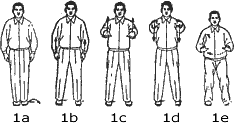
Face N 12 (1a) . For an explanation of the
directional scheme used in Cloud Hands webpages, please see below.
Stand at attention for awhile in 1a. Bring more awareness to the feet and
legs, sink, ground yourself, melt with gravity. In Taiji and Qigong, standing quietly in a
meditative posture like 1a for awhile is an important phase.
Take your time, don't rush.
Loosen up and relax (Sung). Shoulders are down, hands
relaxed and gently touching the side of leg, and head is erect. This is the phase of
WuJi (empty state), or standing like a tree (Zhan
Zhuang), or post standing, in central equilibrium, reconnecting with oneness and
emptiness. Breathe
easily and comfortably. Meditate as is in 1a. [Your Tai Chi practice
could also end here, and you do only Wuji Qigong for an hour ... not my
favorite.]
Sink weight into right leg, and then step out to the left to shoulder width (1b).
Gently raise both arms up (1c), palms facing down, to about shoulder height
(1d).
Lower both arms, palms down, to Dan Tien height, while bending at the
hips and lowering the
knees (1e).
The lower Dan Tien is a sphere of energy located a few
inches behind and below the level of the navel or belly button; the middle
Dan Tien is located in the heart area, and the upper Dan Tien is
located behind the eyes in the brain. The most important for Taijiquan is the
lower Dan Tien. Practitioners of Kundalini Yoga might
consider correspondences of the 3rd Chakra (Manipurna) [Power,
Will] with the Lower Dan Tien, the 4th Chakra (Anahata)
[Compassion, Love] with the Middle Dan Tien, and the 6th Chakra (Aina)
[Intuition, Vision, 6th Sense] with the Upper Dan Tien. The Chinese
energetic system is quite different from the Indian energetic system, so
correspondences are weak in this case. [Chris Akley wrote on 4/3/2012 that
"Though I wouldn't say that this is wrong, I think there is a more accurate way
to describe it. You could also say that the Dan Tien is in the second
charka Swadhisthana which is where kundalini
resides once it is awakened. But more accurately, I would say it is between the
second and third chakra as this Qigong healer
says, in between the
energies of fire and water.] Despite my being sometimes confused by
esoteric ancient anatomy and physiology, I do include some of it anyway for
reference purposes. Chinese meridian anatomy is impressive.
This is movement often called "Raising Hands and Lowering Hands."
Breathe normally as you stand, relax, and center in position 1a. Breathe
in through nose, and out through the nose. Slow the respiration rate to
inhaling for 4-5 seconds, holding the full in-breath for 1-2 seconds, exhaling
slowly for 4 to 5 seconds, pausing 1-2 seconds before beginning the yin/yang
cycle of breathing again. Breathe in at 1a, breathe out as you step to 1b.
Breathe in as arms float up 1b-1c, and breathe out as arms float down (1d-1e).

1a. Opening Posture of Taijiquan, Wuji, Standing Meditation Posture
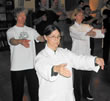
1d. Opening Posture of Taijiquan, Raise Hands and Lower Hands
Here is a description of the beginning of the Opening Posture of Taijiquan (#1, 1b) from the book Traditional Chen Style Taijiquan by Fan Chun-Lei and A. Frank Shiery, p.37:
"1. Preliminary Stance:
Stand naturally upright with the feet placed shoulder-width apart, toes pointed
slightly inward, and arms hanging naturally at the side. The body should
be kept upright with the shoulders relaxed, eyes slightly closed and breathing
naturally. The body should face north. The mind should remain empty,
calm and clear. This is the state of WuJi, (Negative Terminus in
Taoist Teaching).
2. Commencing Form: The body should exhibit being
relaxed externally while solid within. The head is held naturally erect as
if pulled upward by an invisible string. Close the lips slightly with the
tongue touching the upper palate. The toes firmly grasp the ground with
Yongquan point pulled upward. The eyes are looking straight
ahead with the chin drawn slightly inward. The hip is turned up and the
coccyx turned back and upward with the waist directed downwards. The
whole body should remain relaxed. A mind state of
intent is maintained while the vital energy flows upward from the Dantian
to the Baihui point, while the turbid energy flows downward from the
Dantian to the Yongquan point. During this time, the body
exhibits no external movement. Yin/Yang, for example,
closing/opening, supple-firm and fast-slow are manifested internally, portraying
the image of the Taiji, (Grand Terminus) (1b).
Key Points to Remember: For the beginner, the primary
concern should be to cleanse the mind and spirit of tension and anxiety,
removing all negative thoughts. This develops even-temperedness and an
alert mind for quick movement and response. Once this technique has been
mastered, the practitioner can begin to understand and practice Taijiquan more
effectively."
- Fan Chun-Lei and A. Frank Shiery,
Traditional Chen Style Taijiquan
I enjoy doing raising and lowering hands, being coordinated, keeping yin and yang in balance, rising up and lowering down, floating up and sinking down, breathing in on up and breathing out on down. Energized leg, controlling waist, rotating, energy up the back out the shoulders and out to the hands. Simple and symbolic.
Some people do a Tai Chi salute: 1a, step forward, right fist covered by left palm, bow, return to 1a, 1b ... A Tai Chi mudra. I think the Tai Chi Salute is very cool, but I never do it while practicing alone. Most Taijiquan practice is done while you are alone.
For more information, descriptions, explanations, and interpretations about the
Commencement or Opening
Movement One of the Yang Style of Taijiquan, please check out my
webpage on this
subject.
Relaxation (Sung, Song, Fan Song) is essential to the successful, beneficial, and full body-mind experience of openness, effortlessness, and beauty of any style of Taijiquan.
Standing Meditation: Lessons, Bibliography, Quotations, Resources. Research by Mike Garofalo.
Rooting and Central Equilibrium
"Up and Down Hands": The Alpha and Omega of Taijiquan Practice. By Gerald A. Sharp. Qi: The Journal of Traditional Eastern Health and Fitness, Volume 25, No. 1, Spring, 2015, pp. 18-24.
2. Wild Horse Shakes Its Mane
Variations of names for this movement include: Parting the Wild Horse's Mane, Wild
Horse Waves His Mane, and
野马分鬃 : Ye Ma Fen Zong :
Parting the Wild Horse's Mane.
The general direction of movement is in a straight line from E3 towards W9 in Movement #2. Part the Wild Mustang's Mane Three Times: 1. To the left side (2e), 2. To the right side (2j), and 3. To the left side (2o). Please study the recommended online videos to see how the series of postures in this particular movement are performed.
When performing the short form, players should: move slowly, move continuously, keep the movements rounded, move without great effort, relax, keep the head up, let the mind direct the movements, don't bounce, and maintain an upright posture. Breathe in through the nose and out through the mouth, breathe deeply and regularly, breathe in when pulling back or reaching up, and breathe out when going forward or reaching down. All the basic principles found in the T'ai Chi Ch'uan Classics should be followed when doing the Beijing simplified Taijiquan form.
"Yin is passive, yielding,
earthy and supportive; whereas Yang is
expansive, active, upward, and outward. When
your weight is all on one leg, that leg is Yin (supportive,
earthy, inactive, yielding), and the stepping leg is Yang (active,
upward, outward, expansive)."
- Robert Chuckrow, Tai Chi
Dynamics, p.40


Gently rise up to normal height
(2a). Circle right arm counter-clockwise up to chest height,
with the palm facing down. Draw left arm to waist, with the palm facing up
(2a). Imagine holding a ball between the two hands. Turn the
waist to NE1 (2b). Draw the left foot to the side of the right foot (2b). Hold Tai Chi "energy ball" with
right hand,
palm down, at chest height; and left hand below, palm up, at Dan Tien height
(2b). Relax and gently inhale.
"Part Wild Horse's Mane to the Left" by stepping diagonally with the left leg (2d), bring left hand out, palm up, to about chest height (2e). Exhale as the left arm extends. Left elbow is slightly bent. Right hand moves down to right hip (2e), with the right palm down. End with chest facing W9, left hand to SW7. Left bow stance with 60% of weight in forward left leg (2e), left knee bent; and, 40% of weight in rear right leg, with leg bend. Head upright. Shoulders down.
"Part Wild Horse's Mane to the Right" by first drawing the weight back into the right leg, pivot on left heel (2f), drawing the left hand back as the torso turns to face SW7 (2g). Step forward with the right foot to side of left foot (2g). Step out the right leg to the diagonal (2i). Exhale as the right arm extends (2i). Right elbow is slightly bent. Left hand moves down to left hip (2j), with the left palm down. End with chest facing W9, left hand to NW11. Right bow stance with 60% of weight in forward right leg (2j), right knee bent; and, 40% of weight in rear left leg, with leg bend. Head upright. Shoulders down.
"Part Wild Horse's Mane to the Left" by first drawing the weight back into the left leg, pivot on left heel (2k), drawing the right hand back as the torso turns to face SW7 (2k). Step forward with the left foot to side of right foot (2l). Step out the left leg to the diagonal (2m). Exhale as the left arm extends (2n). Left elbow is slightly bent. Right hand moves down to right hip (2o), with the right palm down. End with chest facing W9, right hand to SW7(2o). Left bow stance with 60% of weight in forward left leg (2o), left knee bent; and, 40% of weight in rear right leg, with right leg bend (2o). Head upright. Shoulders down. Look towards W9.
2e. Parting the Wild Horse's Mane, Left Side
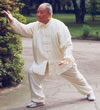
2j. Parting the Wild Horse's Mane, Right Side
Study Yang Style Taijiquan with Mike Garofalo in Red Bluff, California
3. White Crane Spreads Its Wings
Variations of names for this movement include: White Stork Spreading Its
Wings, White Crane Lifts Its Wings, White
Stork Cools Its Wings;
白鵝亮翅 : Bai E Liang Chi.
The general direction of movement is in a straight line from E3 towards W9 in Movement #3.
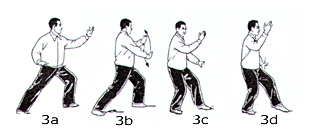
2o = 3a. From 3a draw the right foot forward
a half step (3b). The right hand moves upward (3b) as the left hand moves
downward (3b). Draw the left foot backward (3c) as the right hand moves up
and left hand moves down (3c). Finish (3d) with the right hand above the
head and palm forward, in a left toe stance with 90% of the body weight in the
back right leg, and the left hand rests along left leg with palm down. End with chest facing W9.
Face to W9. Relax and exhale as the weight settles down in the back right
leg.
Notice how the body turns at the waist slightly to left SW7 (3b) and then to the right NW11 (3c) before it settles to face W9. This represents the subtle internal rotation of the Dan Tien, a "silk reeling" movement, more pronounced in the Chen Style of Taijiquan than in Yang Style Taijiquan, but still present in all styles of Taijiquan. Many movements in the 24 Form include this turning of the waist from side to side, and rotation of the Dan Tien.
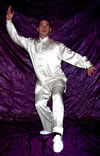


3d. White Crane Spreads Its Wings
4. Brush Knee
Variations of names for this movement include: Twist Step, Brush Knee,
Palm Strike; Brushing Your Knees and Stepping; Brush Knee and Twist Step; and 左搂膝拗步 : Lou Xi Ao Bu
: Brush Knee and Twist Step.
The general direction of movement is in a straight line from E3 towards W9 in Movement #4. Please study the recommended online videos to see how the series of postures in this particular movement are performed.



3d = 4a.
Brush left knee and right palm strike (4a-4h). Left Knee and palm
Twist Step (4b), turn body clockwise (4c-43), Brush Left Knee (4f), Right Palm Forward Strike
(4h). End with chest
and face facing W9, look to W9 (4h). 4h = 4i.
Brush right knee and left palm strike (4i-4o). Twist Step (4j), turn body counter-clockwise (4k-4l), Brush Right Knee (4m), Left Palm Forward Strike(4o). End with chest and face facing W9, look to W9 (4o). 4o = 4p.
Twist Step, Brush Left Knee, Right Palm Forward Strike. End with chest facing W9.
Relaxation (Sung, Song, Fan Song) is essential to the successful, beneficial, and full body-mind experience of openness, effortlessness, and beauty of any style of Taijiquan.

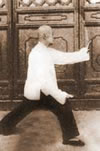
![]()
![]()
4o. Brush Right Knee
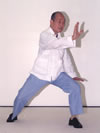
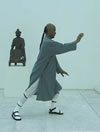
4u. Brush Left Knee
5. Playing the Lute
Variations of names for this movement include: Play the Guitar, Strumming the Lute,
Hand-hold the Lute, Playing the Pipa, and 手挥琵琶 : Shou Hui Pi Pa : Hand Strums the Lute.
The general direction of movement is in a straight line from E3 towards W9 in Movement #5.

4u = 5a. End with chest facing W9, and look
to W9.
Here is a description of Playing the Lute "Hand-hold the Lute" (#5, 5a-5d) from the book 'Tai Chi for Health: The 24 Simplified Forms" by Cheng Zhao and Don Zhao, p.88:
"Form 5 resembles a person playing a
lute, a common music instrument in old China's time. It is more accurate
to describe it as hands holding the lute, which is also a literal translation
from its counterpart in Chinese.
1. Shift the body weight onto the left leg (5a).
Life the right foot and move it a half step forward, placing it behind the left
foot (5b).
2. Lightly shift the body center back to sit on the
right leg (5c). Extend the left heel a little forward touching the floor
in an empty stance (5c-5d). At the same time, rotate the waist slightly to
the right (5b-5c), lift the left arm and hand upward to the nose level (5b-5c),
lower the right hand to guard the inside of the left elbow (5d)."
- Dr. Cheng Zhao
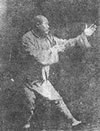
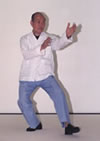

5d. Playing the Lute
Return to Index for Sections or Proceed to Second Section (Movements 6 - 9)
Mike Garofalo's Tai Chi Classes in
Red Bluff, California
Second Section of Standard Simplified 24
Form Taijiquan (Yang Style)
Movements 6 - 9
6. Step Back and Repulse Monkey
Variations of names
for this movement include: Fending Off the Monkey; Step
Back to Drive the Monkey Away; Repulse Monkey and Step Back;
Step Back and Swirl
Your Arms; Reverse Reeling Forearm (Daojuan Gong), Step
Back and Drive Monkey Away, Repulse Monkey, 倒撵猴 : Dao Nian Hou.
The Direction of Movement is reversed. Move backward in a straight line from W9 in the direction of E3. Please study the recommended online videos to see how the series of postures in this particular movement are performed.


6a = 5d.
Right leg and right twisting (reverse reeling forearm) arm back, left arm
forward, step back with left leg (6d), exchange arms and move right palm forward
(6d-6e).
Left leg and leg
twisting arm back, right arm forward, step back with right leg (6g), exchange arms
and move left palm forward (6g-6h). 6h = 6i.
Right leg and right
twisting arm back, left arm forward, step back with left leg (6k), exchange arms
and move right palm forward (6k-6l).
Left leg and leg twisting
arm back, right arm forward, step back with right leg (6n), exchange arms and
move left palm forward (6n-6o).
Here is a detailed description of how to perform Repulse Monkey (#6, 6a-60) taken from the
very useful narrative document by David Hann:
"Repulse Monkey (1): Turn your
right hand palm up and let it drop so that your arm moves in an arc (6a-6b). Continue
bringing your right arm back until your hand is level with your right shoulder
(6c).
Turn your left hand palm up and flat, parallel with the earth (6c). Notice that your
torso is facing (6c) to the side (N12) (the same direction as you face when you first
begin, Raising the Chi (1a). Step back with the left foot (6d-6e), taking care to maintain
your stance about a two fist width from your right foot, or about shoulder
width. Now turn your torso to the left, bringing your right arm forward in a
palm strike and your left arm backward as if grabbing an opponent's arm and
pulling (6d-63). Your right palm will now be the most advanced hand (6e).
Repulse Monkey (2): Turn your left hand palm up and let
it drop so that your arm moves in an arc (6e-6f). Continue bringing your left arm back
until your hand is level with your left shoulder (6g). Turn your right hand palm up
and flat, parallel with the earth (6f). Notice that your torso is facing to the
opposite side (S6). Step back with the right foot,
taking care to maintain your stance about a two fist width from your left foot,
or about shoulder width (6g-6h). Now turn your torso to the right, bringing your left
arm forward in a palm strike and your right arm backward as if grabbing an
opponent's arm and pulling (6h). Your left palm will now be the most advanced hand
(6h).
Repulse Monkey (3): Turn your right hand palm up and
let it drop so that your arm moves in an arc (6i). Continue bringing your right arm
back until your hand is level with your right shoulder (6j). Turn your left hand
palm up and flat, parallel with the earth (6j). Notice that your torso is facing
(N12) to
the side (the same direction as you face when you first begin, Raising the Chi.
Step back with the left foot, taking care to maintain your stance about a two
fist width from your right foot, or about shoulder width (6k-6l). Now turn your torso
to the left, bringing your right arm forward in a palm strike and your left arm
backward as if grabbing an opponent's arm and pulling (6l). Your right palm will now
be the most advanced hand (6l).
Repulse Monkey (4): Turn your left hand palm up and let
it drop so that your arm moves in an arc (6l-6m). Continue bringing your left arm back
until your hand is level with your left shoulder (6m). Turn your right hand palm up
and flat, parallel with the earth(6m). Notice that your torso is facing to the
opposite side (S6). Step back with the left foot, taking
care to maintain your stance about a two fist width from your right foot, or
about shoulder width (6n-6o). Now turn your torso to the right, bringing your left arm
forward in a palm strike and your right arm backward as if grabbing an
opponent's arm and pulling (6n-6o). Your left palm will now be the most advanced hand
(6o)."
- David Hann,
Yang Style Short Form Tai Chi
7. Grasping the Sparrow's Tail - Left
Variations of
names
for this movement include:
Grasp the
Sparrow's Tail, Grasping the Peacock's Tail, Grasp the Bird's Tail, Four
Gates, Grasp the Sparrow's Tail to the Left
Side, Hold the Peacock's Tail, 拦雀尾左 : Lan Que Wei Zou
: Grasp the Bird's Tail Left.
"Grasping the Bird's Tail" is the most frequently occurring movement in the Yang Style Long 108 Form. This movement consists of four parts: Ward Off, Roll Back, Press and Push.
The general direction of movement is in a straight line from E3 towards W9 in Movement #7. Please study the recommended online videos to see how the series of postures in this particular movement are performed.


7a = 6o.
Generally, one is moving in the
direction of W9, to your left side, in Movement 7.
Here is a detailed description of how to perform Grasping the Bird's Tail, Left Mode (#7, 7a-7m) taken from the book "Illustrations of Tai Chi Chuan Simplified" by Y. W. Chong, pp. 27-31:
"1. Raise the left hand arch-wise
to the right (7a-7b) and stop it before the right side of the waist (7c).
At the same time bend the right hand horizontally before the chest as if
grasping a ball with both hands (7c). Concurrently draw the left foot back
and put it close to the right one (7b-7c), with the left toes touching the
ground (7c).
2. Lift the left hand outward in a bent manner to the
left as if to ward off a blow (7c-7e) and bow it horizontally at the level of
the shoulders (7e). At the same time swing the right hand downward to the
right (7d-7e) and put it beside the right thigh (7e). At the same time
stretch the left foot out and bow it forward (7d-7e). The eyes are looking
at the left forearm (7e). [Ward
Off Left (Peng
Zuo) I]
3. Stretch the left hand forward, turning its palm
downward (7f). Concurrently turn the right palm upward and stretch it
forward until it comes below the left wrist (7f). Then pull the two hands
downward past the abdomen and swing them up backward to the right until the
right hand comes to the height of the shoulders with its palm upward (7f-7g) and
the left hand comes before the chest with its palm facing inward and the elbow
bend horizontally (7g). At the same time shift the centre of gravity to
the right foot (7g). The eyes are looking at the right hand (7g).
[Roll Back (Lu) II]
4. Draw the right hand back and put it at the inside of
the left wrist (7g). Push both hands forward with the left palm inward and
the right one outward (7h-7i). At the same time bow the left leg forward
(7h-7i). The eyes are looking at the left wrist (7i). [Press (Ji)
III]
5. Separate both hands at the distance of the breadth
across the shoulders with both palms facing downward (7j-7k). Then
lower the upper body slightly backwards (7k), shifting the centre of gravity to
the right foot (7k). At the same time draw both hands back to the two
sides of the waist with both palms facing forward slightly to the ground
(7k-7l). The eyes are looking forward horizontally (7l).
6. Push both hands forward and upward (7l-7m). At
the same time bow the left leg forward (7m). The eyes are looking forward.
[Push (An) IV]"
- Y. W. Chong
I. Ward Off Left (Peng
Zuo) (7b-7e) Inhale 7b-7c, and exhale 7d-7e. Turn
torso to the left towards W9 (7e).
II. Roll Back (Lu) (7f-7g) Inhale 7e-7g. Turn torso to right towards N12 (7g). The hand movements for Roll Back are not shown clearly in the the above illustrations (7f-7g). Look at right hand in the direction of NE2.
III. Press (Ji) (7h-7i) Inhale 7g-7h, and exhale 7h-7i. Torso facing W9 (7i). Turn torso to the left towards W9 (7i). The right palm presses against the left forearm. The left palm faces the body.
IV. Push (An) (7j-7m) Face W9. Push both hands, palms forward, towards W9 (7m). Inhale 7j-7l, and exhale 7l-7m. Torso faces W9 (7m).
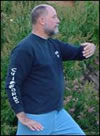
7e. Ward Off, Peng,
Peng Jin, in Grasping the Sparrow's Tail, Left Side
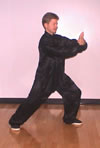
7i. Press, Ji, Ji
Jin, in Grasping the Sparrow's Tail, Left Side
7m. Push, An, An
Jin, in Grasping the Sparrow's Tail, Left Side
8. Grasping the Sparrow's Tail - Right
Variations of names for this movement include:
Grasp the Sparrow's Tail, Grasp the
Bird's Tail, Four
Gates, Grasp the Sparrow's Tail to the
Right Side, Hold the Peacock's Tail, 拦雀尾右:
Lan Que Wei You : Grasp the Bird's
Tail Right.
The general direction of movement is in a straight line from W9 towards E3 in Movement #8. Please study the recommended online videos to see how the series of postures in this particular movement are performed.
"Grasping the Bird's Tail" is the most frequently occurring movement in the Yang Style Long 108 Form. This movement consists of four parts: Ward Off, Roll Back, Press and Push.


8a = 7m. Generally, one is
moving in the direction of E3, to your right side, in Movement 8.
Here is a detailed description of how to perform Grasping the Sparrow's Tail - Right (#8, 8a-8o) taken from the book "Tai Chi Ch'uan and Qigong: Techniques and Training" by Wolfgang Metzger and Peifang Zhou, pp. 106-109:
"Assume starting position (8a = 7m): Arch steps to the left. Left foot load about 70 percent; right foot about 30 percent (8a). Shift weight to the right foot; left foot rotates on the heel by 90° to 120° to the inside (8b). At the same time - with gently held, slightly rounded arms - the hands move with the upper body to the right (8b). Slowly bend arms, with right hand moving in an upward arc (8b-8c), and assume the ball-holding position in front of the right side of the body (8c-8d). While in the ball-holding position, the right foot is pulled towards the left without the toes touching the ground (8d).
1. Ward Off, Right Side. Peng Movement: With an arched step to
the right, pull the left hand as in Form 2 ("Parting Horse's
Mane") in an arc down to hip level (8e-8f), while the right forearm - different
from Form 2 - moves at a left angle in an arc forward and up (8e-8f)
until level with the chest (8f), harmoniously coordinating it with the rotation
of the body (8d-8f) and the shifting of the weight (8e-8f). Position (8f)
is the starting point for the second part of this form. [Ward
Off Right (Peng You) I]
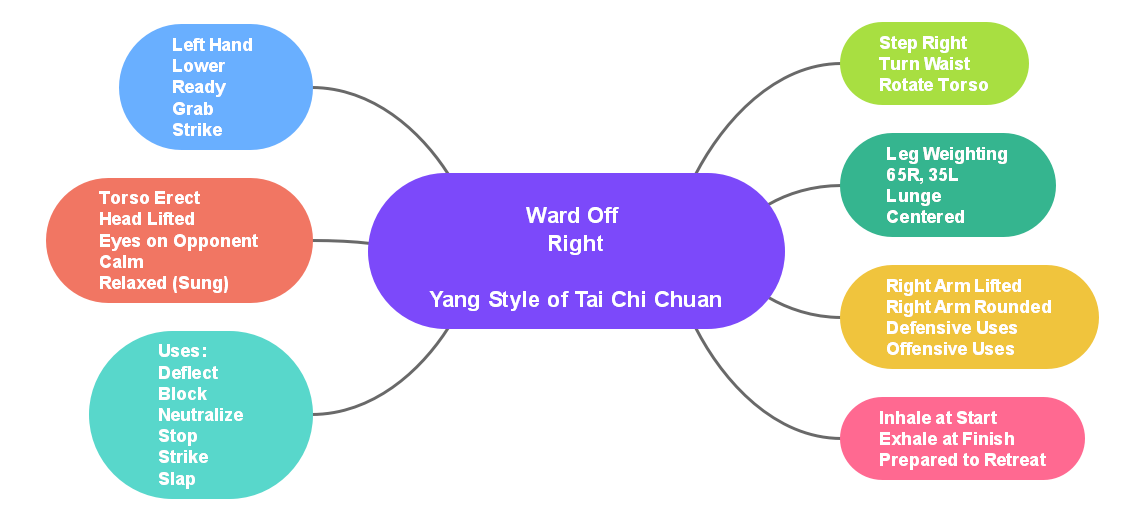
2. Lu Movement: This starts with a slight
rotation of the body to the right SE4 (8g), not shown in the illustration.
While the body rotates to the right, hands are rotating to face each other, the
right hand moving towards the right. Both hands - while shifting the
weight to the left leg (8f-8g) and rotating the body to NW11 - move in an arc
down to the right hip level (8g). [Roll Back (Lu) II]
3. Ji Movement: Preceded by a small
reaching back movement (8h), move the left hand towards the left; both hands
cross at the wrists and are pushed forward and out (8i-8k). When pushing
forward, shift the weight again to the right leg (8k). [Press (Ji)
III]
4. An Movement: at the conclusion of the Ji
movement (8k), turn the hands so that they are crossed (8l) with the palms
facing down, right hand below the left (8l). As the weight is shifted to
the back left leg (8m-8n) - the toes of the right foot raised slightly off the
ground (8n) - the crossed hands separate again and are pulled towards the body
by the elbows (8m-8n). They are then - with a slight shift of of the
body's weight (8n-8o) - pushed forward (8n-8o). Do not straighten your
arms out in the end position (8o). [Push (An) IV]."
- Wolfgang Metzger and Peifang Zhou
I. Ward Off Right (Peng You) (8a-8f) Inhale 8c-8d, and exhale 8e-8f. Turn torso to the right towards E3 (8c-8e).
II. Roll Back (Lu) (8f-8h) Inhale 8g-8h. Turn torso to right towards N12 (8h). The hand movements for Roll Back are not shown clearly in the the above illustrations (8f-8h). Look at right hand in the direction of NW10.
III. Press (Ji) (8j-8k) Inhale 8h-8i, and exhale 8j-8k. Torso facing E3 (8k). Turn torso to the right towards E3 (8i-8k). The left wrist presses against the inside of the right forearm. The right palm faces the body.
IV. Push (An) (8l-8o) Push both hands, palms forward, towards E3 (8n-8o). Inhale 8m-8n, and exhale 8n-8o. Torso faces E3 (8o). Both palms face away from the body.
Relaxation (Sung, Song, Fan Song) is essential to the successful, beneficial, and full body-mind experience of openness, effortlessness, and beauty of any style of Taijiquan.

8f. Ward Off, Peng, Peng Jin, in Grasping the Sparrow's Tail, Right Side
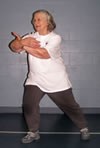
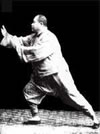
8k. Press, Ji, Ji Jin, in Grasping the Sparrow's Tail, Right
Side
![]()
8o. Push, An, An Jin, in
Grasping the Sparrow's Tail, Right Side
Study Yang Style Taijiquan with Mike Garofalo in Red Bluff, California
9. Single Whip
Variations of names for this movement include: Simple Whip, Whip, Holding the
Whip in One Hand, Holding a Single Whip, 单鞭 : Dan Bian.

The general direction of movement is in a straight line from E3 towards W9 in Movement #9.
From the Push phase (9a) at the end of the Grasping the Sparrow's Tail movement (9a = 8o), begin to rotate the arms from the left side to the right side. The arms draw across the body at about chest height (9a-9c). After the arms reach the left side (9c), then they rotate back to the right side (9c-9d). The waist faces N12 (9c). As the right arm gets to the right side (9d) then the hand extends in the direction of NE1 (9e) and the hand is shaped into a beak style (thumb touches the other fingers and all fingers point down) (9e). The left arm is drawn up to the face level, with the palm facing the face (9e). As the right hand forms into beak, the left leg steps to the right, bringing the left foot fairly close to the right foot (9d-9e), and the left toe touching the ground (9e). As the left leg lifts and is placed to face W9, the left hand opens out towards W9 (9e-9f). As the body settles into a left bow stance (9g), the left hand pushes forward, palm facing out. We end in Single Whip (9g) with the waist facing NW11, in a left bow stance, pushing with the left palm in the direction of W9, with the right arm lifted and pointing towards NE1, beaked right hand, and looking towards W9 (9g). Inhale 9d-9e, and exhale 9f-9g.
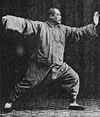
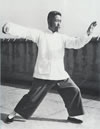
9g. Single Whip, Dan Bian
Return to Index for Sections or Proceed to Third Section (Movements 10 - 15)
Third Section of Standard Simplified 24
Form T'ai Chi Ch'uan (Yang Style)
Movements 10 - 15
10. Waving Hands Like Clouds
Variations of
names for this
movement include:
Moving Hands Like Clouds, Waving Hands Like
Clouds, Cloud Built Hands, Wave Hands in Clouds, Cloud Hands 云手 : Yun Shou.
The whole Cloud Hands (Yun Shou) movement flow is from the left to the right, from E3 towards W9.
Cloud Hands is a gentle flowing movement that is rather complicated to describe. Please study the recommended online videos to see how the series of postures in this particular movement are performed.


From the Single Whip position (10a = 9g) begin to turn the torso to the right side (10a-10e) until the front of the body is facing N12 (10c). At the same time as the torso turns toward the right side, the right hand remains outstretched (10b-10c). The left hand moves downward and then upwards toward the right side (10b-10c) until it reaches the level of the head (10d). The weight moves into the bent right leg (10c). The head turns and looks towards the right side E3 (10d).
The left hand, palm facing the
body, remaining at about face level, moves across the body towards the left side
(10d-10f). The right hand, at about waist level, palm facing the body,
moves across the body towards the left side at the same time as the left hand
moves (10e-10f). The waist turns to move the arms more than the shoulders
move the arms (10e-10f). Turn the waist and move the arms until you reach
the left side and are looking towards W9 (10f).
Step with the right leg and move it closer to the left leg as the arms move to
the far left position W9 (10e-10f). Switch the position of the arms by
moving the right arm to about face level (10e-10f), and the left arm down
towards the waist level (10f). This completes the first part of the Cloud
Hands movement by moving from the far left (10a) to the far right (10c) and then
from the far right (10c) to the far left (10f) in a gentle flowing manner
(10b-10f), moving the hands like floating clouds.
From the far left position (10f) with the right hand high (10f) and the left hand low at waist level (10g), with both palms facing the body, move both arms to the right across the body (10g-10h). The waist turns to move the arms more than the shoulders move the arms (10f-10h). Turn the waist and move the arms until you reach the far right side and are looking towards E3 (10h). When you reach the far right, exchange the arms by bringing the left arm up to about face level (10i) and the right arm down to about waist level (10i-10j), and at the same time step the left leg to the left W9 (10h-10i). Now begin to move the left arm across the body to the left side at about face height, palm facing the body (10i-10k), at the same time as the right arm drops down to about waist level (10i-10j) and moves across the body, palm facing inward, to the far left side (10j-10k). When the left hand reaches the far left side (10j), lift and step with the right leg towards the left leg (10j-10k). This completes the second part of the Cloud Hands movement by moving from the far left (10f) to the far right (10i) and then back to the far left (10k) in a gentle flowing manner, moving hands like floating clouds.
From the far left position (10k) with the right hand high (10k) and the left hand low at waist level (10l), with both palms facing the body, move both arms to the right across the body (10k-10n). The waist turns to move the arms more than the shoulders move the arms (10k-10n). Turn the waist and move the arms until you reach the far right side and are looking towards E3 (10m). When you reach the far right, exchange the arms by bringing the left arm up to about face level (10n) and the right arm down to about waist level (10m-10n), and at the same time step the left leg to the left W9 (10m-10n). Now begin to move the left arm across the body to the left at about face height, palm facing the body (10n-10p), at the same time as the right arm drops down to about waist level (10m-10n) and moves across the body, palm facing inward, to the far left side (10n-10p). When the left hand reaches the far left side (10p), lift and step with the right leg towards the left leg (10o-10p). This completes the third part of the Cloud Hands movement by moving from the far left (10k) to the far right (10m) and then back to the far left (10p) in a gentle flowing manner, moving hands like floating clouds.


10f. Waving Hands Like Clouds
11. Single Whip
Variations of names for this movement include: Simple Whip, Whip,
Single Whip, Holding the Whip in One Hand, 单鞭 : Dan Bian.

From the last posture of Cloud Hands (10p = 11a), step forward with the right foot a small step (11b). Begin to rotate the arms from the left side to the right side. The arms draw across the body at about chest height (11a-11c). After the arms reach the left side (9c), then they rotate back to the right side (11c-11e). The waist faces N12 (11c). As the right arm gets to the right side (11d) then the hand extends in the direction of NE1 (11d) and the hand is shaped into a beak style (thumb touches the other fingers and all fingers point down) (11e). The left arm is drawn up to the face level, with the palm facing the face (11d). As the right hand forms into beak, the left leg steps to the right, bringing the left foot fairly close to the right foot (11c-11d), and the left toe touching the ground (11d). As the left leg lifts and is placed to face W9, the left hand opens out towards W9 (11d-11e). As the body settles into a left bow stance (11f), the left hand pushes forward, palm facing out (11e-11f). We end in Single Whip (11f) with the waist facing NW11, in a left bow stance, pushing with the left palm in the direction of W9, with the right arm lifted and pointing towards NE1, beaked right hand, and looking towards W9 (11f). Inhale from 11b-11d and exhale from 11e-11f.
11f. Single Whip, Dan Bian
12. Pat the Horse on the Back
Variations of names for this movement include:
High Pat on Horse, Patting the
Horse's Neck While Riding, Stroke the Horse From
Above, Asking for Directions While Riding a Horse, Pat the Horse's Back, Pat the
Horse on the Back, 高探马 : Gao Tan Ma : High Pat
on Horse.
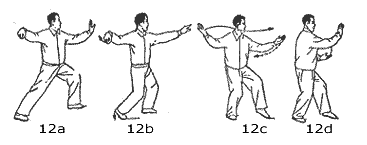
From Single Whip (12a), draw the right foot forward a half-step (12b). The right hand changes from a beaked hand into an open hand (12b). The right arm moves forward at about face level from right to left in the direction of W9 (12b-12c), and ends with palm facing out in front of the body at face level. The torso turns to the left and ends facing W9 (12c-12d). The right hand stops at face level, with the palm facing out and away (12d). The left hand moves in a downward arc (12c-12d) to the Dan Tien level, and ends with the left palm facing up (12d). The left leg is in an empty toe stance (12d) The body is facing in the direction of W9 (12d). The final position is called High Pat on Horse (12d). Inhale at 12c and exhale at 12d.

12d. High Pat on Horse, Pat the Horse on the Back
13. Kick with Right Heel
Variations of names for this movement include: Right Heel
Kick, Kicking Straight Right Mode, Kicking with the Right Heel, 右蹬脚 : You Deng Jiao: Right
Heel Kick.
The general direction of movement is in a straight line from E3 towards W9 in Movement #13. Please study the recommended online videos to see how the series of postures in this particular movement are performed.

Lift left leg and step forward (13a-13b). Circle both hands outward in a
circle and down (13b-13c). Step with right leg forward to bring the right
foot next to the left foot (13c-13d). At the same time, circle both hands
upwards and bring the right hand in front of the left hand, crossing the hands
in front of the face (13d-13d). Left the right leg as both hands move away
from each other towards the sides (13e), palms facing out and fingers up (13f).
Turn the body slightly to the left so that instead of your waist facing W9 it
faces SW7. Kick with the left heel in the direction of NW10 (13f).
Inhale 13c-13d, and exhale 13e-13f.
Some persons may not be able to kick high with a straight right leg and right toe drawn back - a right heel kick (13f). Instead, substitute a toe kick, while kicking lower if necessary, or bending the knee if necessary. Don't let the inability of executing a movement perfectly, according to a standard, prevent you from practicing Taijiquan. Adapt accordingly to accommodate for injuries, balance problems, inflexibility, or weakness. Be practical and smart; and, make reasonable adjustments. Keep practicing, and you will probably see steady improvements, increased strength, and greater flexibility.
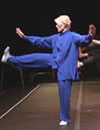
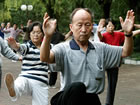
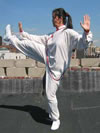
![]()
13f. Kick with Right Heel
14. Hitting Your Opponent's Ears with Both Fists
Variations of names for this movement include: Box Ears, Box Opponent's Ears with Both
Fists, Strike to Ears with Both
Fists, Strike to Temple with Both Fists, 双峰灌耳 : Shuang Feng Quan Er :
Twin Fists Strike Opponents Ears.
The general direction of movement is in a straight line from E3 towards NW10 in Movement #14.
.
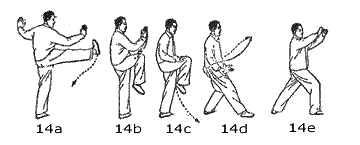
From the Right Heel Kick position (14a = 13f), draw the right knee back into the body to waist level (14a-14b). Draw both hands down and bring the elbows to the sides of the body, closing the open hands into fists and holding the hands level with the knee (14b-14c). Step forward with the right leg (14c-14d) in the direction of NW11. Circle the arms outward from the body (14d), and then draw both fists towards the head level of an imaginary opponent to strike the opponent's temples with both fists (14d-14e). Settle into a right bow stance (14e). The imaginary opponent is in the direction of NW10 or NW11 (14e). Look intensely at the imaginary opponent. Inhale 14b-14d, and exhale 14d-14e.


14e. Hitting Your Opponent's Ears with Both Fists
15. Kick with Left Heel
Variations of names for this movement include: Turn Around,
and Kick with Left Heel; Left Heel Kick, Turn Around and Kick with Left Heel, 左蹬脚 : Zuo Deng Jiao : Left Heel Kick.
The Direction of Movement is reversed. Move backward in a straight line from NW10 (15a) in the direction of E3 (15b-15g). Please study the recommended online videos to see how the series of postures in this particular movement are performed.

Turn 270 degrees clockwise, face to NE2. Cross and separate hands at face, heel kick with left foot. Left arm in front and right arm in back at shoulder height. Inhale 15c-15e, exhale 15f-15g.
15g. Kick with Left Heel
Return to Index for Sections or Proceed to Fourth Section (Movements 16 - 19)
Fourth Section of Standard 24
Form Taijiquan (Yang Style)
Movements 16 - 19
16. Snake Creeps Down Left Leg, Golden Rooster Stands on Left Leg
Variations of names for this
movement include:
Squat Down on Right Leg, Snake
Creeps Down Left Leg: Crooked Whip to Right Side: Squat on Right, Climb Down
Left; Golden Rooster Stands on One Leg, Left Down One-leg Stand,
下势 : Xia Shi : Snake Creeps
Down, 左金鸡独立 : Zuo Jin Ji Du Li :
Golden Rooster Stands on Left Leg.
The Direction of Movement is reversed. Move backward from in a straight line from W9 in the direction of E3 (16a-16h). Please study the recommended online videos to see how the series of postures in this particular movement are performed.

16a = 15g. Squat down
and balance on right leg (16d-16e). Right arm draws back in single whip
(16c), and right
hand makes a beaked fist (16c).
Extend left leg low to E3 (16e). Draw the left arm down along inside of left leg
towards left ankle ... the snake creeps down (16d-16e).
Stand up on left leg (16f-16h). Draw right leg up until level with hip
(16h). Right
elbow is over right knee, right had pointing up (16h).
This final posture, facing E3, is called "Golden Rooster Stands on Left Leg,
Golden Bird Standing Alone" (16h).

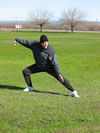
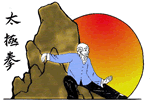
16e Snake Creeps Down Left Leg
![]()
![]()
![]()
16e Snake Creeps Down Left Leg
Golden Rooster Stands on Left Leg
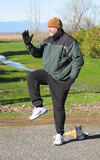
![]()
16h. Golden Rooster Stands on Left Leg
17. Snake Creeps Down Right Leg, Golden Rooster Stands on Right Leg
Variations of names for this movement include: Squat Down on Left Leg, Snake
Creeps Down Right Leg; Crooked Whip to the Left Side: Squat on Left, Climb Down
Right; Golden Rooster Stands on One Leg, Right Down One-leg Stand, 势 : Xia Shi : Snake Creeps
Down, 右金鸡独立 : You Jin Ji Du Li : Golden Rooster Stands
on Right Leg.
The general direction of movement is in a straight line from W9 towards E3 (17a-17h). Please study the recommended online videos to see how the series of postures in this particular movement are performed.

17a = 16h. Squat down and balance on left leg (17d-17e). Left arm draws back in single whip, and left hand makes a beaked fist (17c). Extend right leg low to E3 (17d-17e). Draw the right arm down along inside of right leg towards ankle ... the snake creeps down (17d-17e). Stand up on right leg (17g-17h). Draw left leg up until level with hip (17g-17h). Left elbow is over left knee, left had pointing up (17h). This final posture, facing E3, is called "Golden Rooster Stands on Right Leg, Golden Bird Standing Alone" (17h).
![]()
![]()
![]()
17e Snake Creeps Down Right Leg
Golden Rooster Stands on His Right Leg
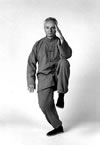

17h Golden Rooster Stands on His Right Leg
18. Fair Lady Works the Shuttles
Variations of names for this movement include: Throwing the Loom to the Left Side
and Right Side, Shuttle Back and Forth,
Two Corners, Work at Shuttles on Both Sides, Jade Maiden Works the Shuttles, 玉女穿梭 : Yu Nu Chuan
Suo :
Fair Lady Works at Shuttles.
The general direction of movement is in a straight line from W9 towards E3 (18a-18m). Please study the recommended online videos to see how the series of postures in this particular movement are performed.


18a = 17h. From "Golden Rooster on Right Leg (18a) step left foot forward
and diagonally (18b-18c), draw right foot to left foot (18e), step out with
right foot
diagonally to right (18f-18g). Raise right arm to block out
above head (18g-18h), palm facing out. Left palm strike (18h). Right leg bow stance
(18h).
Bring left leg up by right leg (18h-18j), and bring arms to chest (18i). Step diagonally
to the left side with left foot (18k-18l). Raise left arm to block out above head, palm
facing out (18k-18m). Right palm strike (18m). Left leg bow stance
(18m).
Here is a description of how to perform Fair Lady Works the Shuttles ("Works at Shuttles") (#18, 18a-18m) from the book 'Tai Chi for Health: The 24 Simplified Forms" by Cheng Zhao and Don Zhao, p.126:
"Form 18. Fair Lady Works at
Shuttles (Left and Right Sides.).
(1) Step forward on your left foot; shift your body weight
onto the left leg (18b-18c). Draw you right foot forward in such that the
toes touch the ground beside your left foot (18c-18d). At the same time,
your arms hold a large ball in front of your chest with the left hand above the
right (18e). Face NE2 (18e).
(2) Rotate your waist to the right and place your right foot
forward with the right heel touching the ground first (18e-18f). Then
shift 70% of your body weight onto the right leg and from a right bow stance
(18h). At the same time, rotate the right arm up so the hand is level with
your forehead and the palm faces out (18h). Face SE4 (18h). [Inhale
18e-18f, exhale 18g-18h.]
(3) Shift your body weight back to the left leg, and
rotate your waist slightly to the right (18i-18j). Shift your body weight
back to the right leg, drawing your left foot up to rest beside your right foot
with the toes touching the ground (18j-18k). At the same time, both arms
hold a large ball in front of your chest with the right hand above the left
(18k). Face SE4 (18k).
(4) Rotate your waist to the left and place your left
foot forward with the left heel touching the ground first (18l-18m). Then
shift 70% of the body weight onto the front leg forming a left bow stance (18m).
At the same time, rotate the left arm up so the hand is level with your forehead
and the palm faces out (18l-18m). Face NE2 (18m)." [Inhale
18j-18k, and exhale 18l-18m.]
- Dr. Cheng Zhao
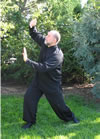

18h Fair Lady Works the Shuttles to the Right Side
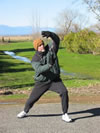

18m Fair Lady Works the Shuttles to the Left Side
19. Pick Up the Needle from the Bottom of the Sea
Variations of names for this movement include: Pick Up Needle from Bottom of the Sea, Needle at Bottom of the Sea, Find the Needle at the Sea Bottom, Reach for the Moon in the Lake, 海底针 : Hai Di Zhen : Needle at Sea Bottom.
The general direction of movement is in a straight line from W9 towards E3 in Movement #19.
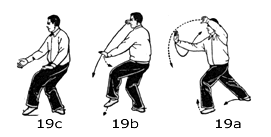
From the last posture of "Fair Lady Works the Shuttles" (18m = 19a), begin by stepping forward a half step with the right leg (19a). The right hand moves back and up to the right (19a) until it is drawn up to around face level on the right side (19b). The left hand moves down in an arc until it comes to stop at about waist height over the left leg (19a-19b). Lift up the left leg and step forward a half step into a left toe stance (19b-19c). Settle the body weight into the right leg (19c). Reach down with the right hand, fingers pointing downward, until the right hand is below the waist. Face the body in the direction of E3 (19c). Inhale 19a-19b, exhale 19c.


19c Pick Up the Needle From the Bottom of the Sea
Return to Index for Sections or Proceed to Fifth Section (Movements 20 - 24)
Fifth Section of Standard Simplified 24
Form Tai Chi (Yang Style)
Movements 20 - 24
20. Flashing the Arms Like a Fan
Variations of
names for this
movement include:
Flashing the Arms,
Fend Off and Push Away with Arms, Unfolding Arms Like a Fan, Fan Through the
Back, Flashing the Arms, Shunting with Both Hands Fanned,
扇通背 : Shan Tong Bei : Fan
Through the Back.

The general direction of movement is in a straight line from E3 towards W9 in Movement #20.
From the final posture of "Pick Up the Needle from the Bottom of the Sea" (19c = 20a), begin by lifting the left leg up and then stepping forward onto the left heel (20b-20c). Lift the left hand and move it forward towards E3, fingers upward, palm facing S6 (20b-20c). The right hand moves up and back to the left, finishing above head level, palm facing S6, fingers pointing upward (20c-20d). Sink the body weight into the left leg, and take a left bow stance (20c-20d). Inhale 20a-20c, and exhale 20c-20d.

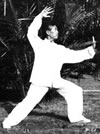
20d Flash the Arms Like a Fan, Fan Through Back
21. Deflect, Parry and Punch
Variations of names for this movement include: Turing
Around, Warding Off, Punching; Turn, Intercept and Punch; Turn Body,
Shoulder Strike, Back Fist, Deflect, Parry, and Punch, Turn to Deflect Block and
Strike, 进步搬拦捶 : Jin Bu Ban Lan Chui : Step Forward, Parry Block and Punch.
The general direction of movement is in a straight line from E3 towards W9 (21a-21h). Exhale on the punch (21g-21h). Please study the recommended online videos to see how the series of postures in this particular movement are performed.

21a = 20d.
Here is a detailed description of how to perform Deflect, Parry and Punch (#21, 21a-21h) taken from the very useful narrative document by David Hann:
"Turn, Intercept, and Punch: Turn
to the right on your left heel so that you are facing to your rear, looking over
your right shoulder (21b). Your left hand is held, palm facing out, at least a
hand's width from your head. Your right hand is formed into a fist, held about
chest level, with the elbow below the fist (21c). Step out with your right foot
and strike out and downward with the back of your fist (21d). Step up to your
right foot with your left foot, toe down, heel up (21e). Bring your right fist
back to your right waist (21f). Bring your left arm across your body as if
blocking an opponent's punch and bring your left hand, palm open, facing and in
front of your right fist (21f). Step forward with the left foot (21g) and punch
with your right fist (21g-21h), moving it over your left hand, which is now
turned flat, palm up (21h)."
- David Hann,
Yang Style Short Form Tai Chi
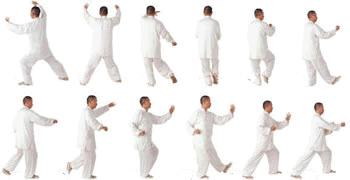

21e Parry, Left Leg Steps Forward (21e, 21f, 21g), Punch with Right Fist
21e, 21f, 21g Could be a time for Fa Jin power punch, like Cover Hands and Strike with Fist or Double Cannon Fists in the Chen Style Taijiquan. However, Yang Style of Taijiquan is much more reserved in its expression of speed or power.
22. Apparent Close and Push
Variations of names for this movement include: Clearing Cross Block and Pushing, As if Blocking and Closing,
Appears Closed,
Withdraw and Push, Closing a Door, 如封似闭 : Ru Feng Si Bi :
Apparent Close Up.
The general direction of movement is in a straight line from E3 towards W9 (22a-22g).

From the end of Deflect, Parry and Punch (21h = 22a), begin by drawing the left
hand under the right hand from the forearm towards the right hand (22a-22b).
Both hands come together in front of the body facing W9 (22c). Draw both
arms backwards towards the body (22d-22e) as the weight shifts backwards into
the right leg (22d). As both hands reach the waist (22e) the weight is in
the back right leg (22e) and the left toe rises (22e). Begin to move
forward again in the direction of W9, drawing the weight into the left leg and
taking a left bow stance (22f-22g). Both arms Push (An) forward,
palms out, elbows bent, pushing in the direction of W9. The waist faces W9
(22g) and the eyes gaze towards an imaginary opponent in front of you (22g).
Inhale 22c-22e, and exhale 22f-22g.
22e, 22f, and 22g could be a time for Fa Jin power Push, An Jin with a lot of muscular li power, like Cover Hands and Strike with Fist or Double Cannon Fists in the Chen Style Taijiquan. However, Yang Style Taijiquan is more reserved in the expression of speed or power. Slower, rising up from the lowered Earth 22e, pushing up and outward 22f and 22g. Power of back and front legs combined to empower and accelerate An Jin application (Push, An).
![]()


22g Push, An
23. Cross Hands
Variations of names for this movement include: Crossing Your Hands in Front of
Chest, Close the Door, Cross Hands, Cross Your Hands,十字手
: Shi Zi Shou : Cross
Hands.

Begin from the Push (An) position (23a = 22g. Gradually turn the
front of the body to the right so as to face N12 (23a-23b). Draw the right
hand in an arc out and across to the left (23b). Draw the weight into the right leg
(23c). Open the arms wide to both sides (23c), palms facing forward, arms
about shoulder height.
Step the right foot back to shoulder width stance (23d). Draw both arms down
in an arc (23d) then
up to cross the hands in front of the chest, holding the right hand in front of left hand (23e).
Face in the direction of N12 (23e). Inhale at 23b-23c, and exhale at 23e.
At 23e reemphasize rooting into the earth, yin enery downward, strong central
equilibrium (zhong ding), power poised, protecting the heart.
![]()

23e Cross Hands
24. Closing Posture of Taijiquan
Variations of
names for this
movement include:
Conclusion, Concluding Posture, Taiji Ending,
Ending Posture, Closing Posture of Taijiquan,
收式 : Shou Shi : Closing.
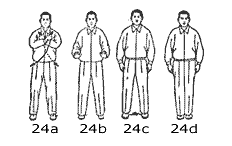
From the final posture of the "Cross Hands" movement (23e = 24a), begin by moving both arms down and outward (24a) until they reach the waist level (23a-24b). The arms continue downward until they are fully extended downward, hands resting against the sides of the thighs (24c). Step to the right with the left leg (24c) until the left foot is immediate beside the right foot (24d). The final position is identical to posture 1a. Keep in mind all the principles discussed for the posture 1a. You have now finished a full performance of the Tai Chi 24 Form. Inhale at 24a, exhale at 24c. Inhale at 24c, exhale at 24d. The body is facing in the direction of N12, as it was in posture 1a.

24d. Ending Posture of 24 Form Taijiquan, Wuji, Standing Meditation Posture
Standard Simplified 24 Tai Chi Form, Names of Movements 1-24, 1 Page, PDF Format, 11Kb
Chart of 24 Form:
B&W Drawing of Movement Sequence (Stepping Diagram) [170Kb, .jpg,
1008px x 591px]
The Stepping Chart show above came from Zhang Fuxing's "Handbook of T'ai Chi Ch'uan Exercises," Samuel Weiser, 1996, p. 65. 9"w x 6"h.
Standing Meditation: Lessons, Bibliography, Quotations, Resources. Research by Mike Garofalo.
Return to the Main Index for this Webpage
Taijiquan:
Standard Simplified National 24
Taijiquan Form
Standard Simplified Version, 24 Movements,
1956, Yang Style Taijiquan
"While making a stride, it is as quietly as a cat walks,
and while putting forth strength the
exertion is so mild that it looks like reeling off raw silk from a cocoon.
The movements,
like clouds floating in the sky, are spry and light, but well-balanced and
steady. Motion is
even and fluid, the muscles neither stiff nor rigid. Breathing should be
deep and even ...
the mind is tranquil but alert, with consciousness commanding the body. In
practicing
T'ai Chi Ch'uan it is essential that movements be guided by consciousness and
that
there be stillness in movement - a unity of stillness and motion."
- Official Chinese instruction manual for the 24 movement short
form, quoted by Howard Reid in his book "The Way of Harmony,"
p. 90.
"The China National Forms developed by China's State
Physical Culture and Sports
Commission was a result of Chairman Mao's call for the nation to use sport to
increase
physical well-being. In 1956 a research team extracted 24 steps from the
Yang style
Taijiquan and rearranged these into the 24 Steps Simplified Taijiquan.
The process
took six years."
- Davidine Sim and David Gaffney, Chen Style Taijiquan, 2002, p.
27.
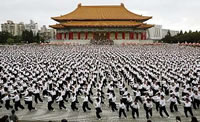
Thousands of People Doing the Tai Chi 24 Form
"In order to popularize Taijiquan, the Chinese National
Sports Committee authorized
the country's four most renowned Taijiquan teachers to compose the 24
Forms Taijiquan. It is based mainly on the Yang style, eliminating many
repetitions and retaining most of the essential principles of Taijiquan. The 24 Forms is
easier to learn
and shorter to practice. The whole set takes around 5 minutes. A
busy person in this
modern age can do three rounds in 20 minutes (including warm up
exercises). This will
be quite adequate to improve and maintain good health. Most clinical
studies of the benefits of Taijiquan are based on people practicing this set of forms.
The 24 Forms
very quickly became the most popular form in the world."
- Paul Lam, An Evaluation of the Combined 42 Forms, Tai Chi, Vol 18, No. 5, October, 1994, pp.26-28.
Li
Tian-Ji (1914-1996) "At the request of Chou En-Lai, China's Prime
Minister, Li Tian-Ji formed the committees of which he was chairman, to create the 24 Step Simpified
Taijiquan,
32 Sword Routine, 66 Combined Routine, 48 Combined Routine and the 88 Yang
Style Routine." Li Tian-Ji is the uncle of
Professor
Professor Li Deyin, one of the creators of the 42 Form Taijiquan competition routine.
“Recognition of somatic training as an essential means towards philosophical
enlightenment and virtue lies at the heart of the Asian practices of hatha yoga,
Zen meditation, and T’ai Chi Ch’uan. As Japanese philosopher Yuasa Yasuo
insists, the concept of “personal cultivation,” or shugyō (an obvious
analogue of “care of the self’), is presupposed in Eastern thought as “the
philosophical foundation” because “true knowledge” cannot be obtained simply by
means of theoretical thinking, but only through ‘bodily recognition or
realization’ (tainin or taitoku). From its very beginnings,
East-Asian philosophy has insisted on the bodily dimension of self-knowledge and
self-cultivation. When the Confucian Analects advocate daily examining one’s
person in the quest for self-improvement, the word translated as “person” is
actually the Chinese word for body (shen 身). Arguing that care of the
body is the basic task and responsibility without which we cannot successfully
perform all our other tasks and duties, Mencius claims, “The functions of the
body are the endowment of Heaven. But it is only a Sage who can properly
manipulate them.” The classic Daoist thinkers Laozi and Zhuangzi similarly urge
the special importance of somatic care: “He who loves his body more than
dominion over the empire can be given the custody of the empire [Laozi, C17].”
“You have only to take care and guard your own body .. and other things will of
themselves grow sturdy;” the Sage is concerned with the means by which to keep
the body whole and to care for life”; “being complete in body, he is complete in
spirit; and to be complete in spirit is the Way of the Sage (Zhuangzi).”
- Richard Schusterman, Body Consciousness, 2008, p.18
"The 24 posture Simplified Form of
Tai
Chi Chuan, sometimes called the "Beijing
form" for its place of origin, is the result of an effort by the Chinese Sports
Committee which, in 1956, brought together four tai chi teachers to create a
simplified form of tai chi as exercise for the masses. The creators truncated
the
Yang style hand form to 24 postures; taking between four and eight minutes
to perform and to give the beginner an introduction to the essential elements of
tai chi chuan, yet retain the traditional flavor of Yang style's longer hand
forms (generally 88-108 postures).[1]
Henceforth this form was avidly promoted by the
People's Republic of China for general exercise, and was also taught to
internees in Communist "re-education" camps. Due to this official promotion, the
twenty-four form is most likely the tai chi form with the most practitioners in
China and the world over (though no surveys have been performed)."
-
24 Simplified Form - Wikipeda
"At this period of wushu, the Nanking
Central Kuoshu Institute in 1956 tasked the choreography of a Taijiquan routine
what would be more suitable for popular dissemination among the masses, in
keeping with the government's egalitarian agenda. The traditional forms
were just too long and time consuming to practice, and the traditional methods
too arcane and demanding for mass propagation. The challenge was to reduce
the one hundred-odd movements of the traditional Yang Style Taijiquan, prevalent
then, to its core, by removing the many repetitive movements as well as the less
essential ones. Thus, the 24-Form Taijiquan set was created.
Instrumental in this simplification effort was Li Tianji (1913-1996) who had
been appointed a wushu research fellow at the Institute. Under official
auspices, the 24-Form Taijiquan quickly became the standard form, taught
throughout China as part of physical education curriculum in schools and
colleges. It is perhaps the best know Taijiquan form in the world today.
As widespread as it is, the 24-Form is at best an abridged version of the
traditional Yang form, a synopsis of the art."
- C. P. Ong,
Taijiquan: Cultivating Inner Strength,
2013, p. 7.
"Li Yulin tuvo dos hijos, Li Tianchi y Li Tianji. El primero
optó por la carrera de la medicina tradicional, mezclando sabiamente los
conceptos clave de la medicina, el Tuina (terapia manual) y las bases de las
artes marciales y el Qigong. El segundo ha llegado a ser conocido como "el Padre
del Taijiquan moderno", por su incansable labor en pro de la difusión del Taiji
y por haber participado en la confección de algunas formas famosas en todo el
mundo, como el Taijiquan simplificado en 24 movimientos (Jianhua Taijiquan).
Li Tianji (1914-1996) nació en el condado Anxin, provincia de Hebei, y comenzó
su aprendizaje de Wushu bajo la tutela de su padre, Li Yulin, a la edad de siete
años. Luego pasó a ser discípulo de Sun Lutang (1861-1933), y de Li Jinglin, con
quien estudió Wudang Jian. Graduado como profesor de Wushu de la Academia
Central a los diecisiete años, Li estaba convencido de la utilidad del Taijiquan
como herramienta para el mantenimiento de la salud y la forma física. Fue así
como llegó a ser el primer profesor que fomentó la práctica del Taiji entre la
gente mayor y enfermos, logrando resultados altamente satisfactorios. Cuando el
Taijiquan fue rehabilitado en la década de los cincuenta, el gobierno chino
estableció una Comisión Estatal de Cultura Física y Deportes, y Li Tianji fue
escogido como su director. Fue así como a mediados de los cincuenta aparecieron
los textos de la forma simplificada en 24 movimientos de Taijiquan, la forma de
66 movimientos, la forma de espada simplificada en 32 movimientos y la forma de
88 movimientos, todas ellas dictadas por el grupo de maestros tradicionales
dirigidos por el Maestro Li. También publicó, en 1980, un texto comprehensivo
sobre la espada de Wudang. Más adelante, el Wushu siguió evolucionando, y Li
Tianji siguió trabajando incansablemente en el desarrollo de las artes marciales,
llegando a ser considerado "Pionero de las Wushu en la nueva China" y "Padre del
Taijiquan contemporáneo", y se premió toda su vida de esfuerzo otorgándole el
título de "uno de los diez mejores Grandes Maestros del Wushu". Hasta el día de
su muerte, el Maestro Li Tianji formó parte del cuadro de profesores del
Instituto de Educación Física y Deportes de Beijing.
Puesto que su trabajo ha consistido en enseñar Wushu durante toda su vida, Li
Tianji ha tenido grandes seguidores y alumnos. Entre los que continúan la
tradición de la esgrima Wudang, cabe mencionar a su hija, Li Defang, y su
sobrino, Li Deyin (1938-), quien estudió Taijiquan y Wudang Jian con su tío,
y posteriormente pasó a ser alumno de Li Jingwu (estilo Chen), Xu Zhiyi (estilo
Wu), Sun Jianyun (estilo Sun) y Hao Jiajun (estilo Yang). Viajó a Shaolin y
Wudang Shan para profundizar en sus estudios. Actualmente, el Maestro Li Deyin
es vicepresidente de la Asociación China de Wushu y actúa en las comisiones de
investigación y desarrollo de nuevos materiales de Wushu y Taijiquan, como
formas de competición, arbitraje y edición de textos."
- Wudang Jian
Mike Garofalo's Tai Chi Classes in
Red Bluff, California
"To have something to promote and maintain the general
health for the large population, the Chinese government in Beijing designed in 1956 a
"simplified
Taijiquan." They selected 24 postures from the Yang's series without
the essential characteristics of Taijiquan. In their written and TV
instructions, only
the external forms are taught. This permits large scale teaching.
The result
is that many persons do it either to rigidly or too meekly. This was
severely
criticized by the prominent Taijiquan expert Li Yaxin of Szechuan Province
who trained with Yang Chengfu for 18 years. While the government
accomplished
its original objective, the popular appeal of this series did hinder the healthy
development of the real art of Taijiquan. This is one of the series Mr. Mozell
called the "watered down version." It is no more than a new set
of continuous
callisthenic movements imitating certain external forms of Taijiquan."
- Master Wu, Ta-yeh, "Suppleness and Strength in
Taijiquan," Internal Arts, Vol. 3, No. 6, November, 1988, p. 8
"Li Tianji studied wushu from his father, Li Yulin, as well as
from his father's masters, Sun Lutang and Li Jinglin. He graduated from the
Shandong
Wushu Institute, became a college professor, the executive of the Harbin Wushu
Federation, and the first chief coach of the China Wushu Team. Li
Tianji has been memorialized as one of the "Ten Best Wushu Masters of China
(Zhongguo Shi Da Wushu Mingshi).
In 1956 Li Tianji created the first standardized simplified taijiquan in Chinese
history: 24-Form Simplified Taijiquan and 32-Form Simplified Taiji
Sword. Both forms opened the door of taiji to novices and non-athletes, and both
are now extremely popular all over the world. For this, he earned the
title "Father of Contemporary Taijiquan."
-
Siu-Fong Evans
"No school of Chinese martial arts is as well known and popular
as Taijiquan. It is suitable for both the young and the old, not only
because Taijiquan possesses special features of stretching, flexing the joints,
softly twining, exercising both the inside and the outside, dispelling diseases
and prolonging life, but it is also the martial art that best reflects Chinese
traditional philosophy. More and more people from other countries,
especially those interested in Chinese culture, are beginning to practice
Taijiquan. Taijiquan is becoming popular all over the world. Because
of this, Taijiquan has no national boundary and is beyond the category of
culture, and belongs to people everywhere."
- Fan Chun-Lei and A. Frank Shiery,
Traditional Chen Style Taijiquan.
The Eight Active Ingredients of Tai Chi
"1. Awareness - including mindfulness and focused
attention. Perhaps the most fundamental ingredient underlying Tai Chi,
the slow, deliberate movements and attention to breathing, body positions, and
sensations, fosters acute self-awareness, a prerequisite to all other
ingredients. The emphasis on moment-to-moment awareness results in
mindfulness and improved focus.
2. Intention - including belief and expectations. Additional active
ingredients of imagery, visualization, and related cognitive tools alter
intention, belief, and expectation, and contribute significantly to the
therapeutic and physiological effects of Tai Chi.
3. Structural Integration - including dynamic form and function. Enhanced integration within and between multiple structural and physiological systems is another key active ingredient that underlies Tai Chi's therapeutic effect. Biomechanically efficient shapes and patterns of movement have functional consequences across many systems.
4. Active Relaxation - Tai Chi's circular, flowing motion helps shift the body and mind into deeper levels of relaxation, and is a form of meditation in motion.
5. Strengthening and Flexibility - Tai Chi provides moderate aerobic training equal to levels obtained by walking at a moderate pace. The integrated movements result in less strain, greater power with less effort, and better balance. The slowness of the Tai Chi movements, in combination with the slightly flexed stances and placing weight on one leg at a time for sustained periods, leads to significant lower extremity strength training and increased loading on the skeleton, which promotes strong bones. In addition, slow, continuous, relaxed, and repetitive movement also results in dynamic stretching, which enhances overall flexibility.
6. Natural Freer Breathing. More efficient breathing improves gas exchange, massages body tissues, including internal organs, helps regulate the nervous system, improves mood, and balances and moves Qi within the body and between the body and the environment.
7. Social Support - including interaction and community. Being part of a group has proven therapeutic value for various medical conditions, including cancer, heart disease, depression and anxiety. In ongoing Tai Chi classes, students develop a strong sense of community, and with rich interactions and support from teachers and peers, often undergo and profound journey of self-discovery.
8. Embodied Spirituality - including philosophy and
ritual. Tai Chi creates a practical framework for practicing living with a
more holistic, Eastern philosophy that integrates body, mind and spirit.
It can also be a powerful vehicle to add a spiritual dimension to your life.
Also, the ritualistic practice of Tai Chi may help amplify and sustain its
therapeutic benefits."
The Harvard Medical School Guide to Tai Chi: 12 Weeks to a Healthy Body, Strong Heart, and Sharp Mind. By Peter M. Wayne, Ph.D., and Mark L. Fuerst. Boston, Shambhala Press,
2013. Index, detailed notes, 336 pages. A Harvard Health Publication. ISBN:
978-1590309421. VSCL. 'The Eight Active Ingredients of Tai
Chi' are explained on pp. 30-65.
Mike Garofalo's Beginning Tai Chi Classes in
Red Bluff, California
"After reaching for the needle at the bottom of the sea,
I looked up, one summer's eve,
to see old Chang
San-Feng open the garden gate,
and join me for Tai Chi.
We said not a word -
hands moving like clouds,
fingers grasping sparrow's tails,
faces smiling, feeling the sun drop,
glimpsing a half moon climbing the clear sky.
Time flowed without
a ripple of memories,
Space embraced a crane cooling its wings,
Being began to sing
softly in tune with the moon.
My dusty black dog
barked,
sensing something on the warm wind;
speaking her mind,
ears up.
Master Chang was gone.
Leaving one shoe on a beanpole, and
a page of poems -
mementos for mortals.
Two black
butterflies
danced wing to wing
in love."
- Mike Garofalo, Encounters with Master
Zhang Sanfeng
Return to the Main Index for this Webpage
|
|
|||
| Time | Performer | Source | |
| 6:25 | Master Paul Lam | DVD 1999, UTube of DVD | |
| 4:44 | M Deu Fu | UTube 2007 | |
| 4:37 | Graceful Lady Master | UTube 2007 | |
| 6:06 | Master Amin Wu | UTube 2016 | |
| 6:28 | Master Helen Liang | UTube 2015 | |
| 7:39 | Master Daniel Tan | UTube 2016 | |
| 4:48 | Sifu May Chen | UTube 2016 | |
| 5:47 | Master Liang, Shou-Yu | Utube 2015 | |
Playing Taijiquan with Others can accelerate your progress towards fitness, vitality, strength of body and mind, and skillfully using your energies.
Return to the Main Index for this Webpage
Strategies for
Learning the Standard
24 Tai Chi Form
Suggestions from Mike Garofalo
The general approach I would recommend is similar to that which I recommended
for learning the 32 Sword Form.
1. You must have a desire to learn, a drive to learn, and a passion for learning and playing Taijiquan. You must have a motivation for learning and a reason for learning, otherwise no tactics for learning will be of help to you.
2. You might want to save this webpage to a folder on your hard drive. Print out this webpage. Place the printout of this webpage in a three ring binder. Keep your study notes while learning the 24 Taiji Form in your three ring binder.
3. Purchase some instructional media (DVD or VHS format) to use to learn the 24 Taiji Form. Here are my recommendations for some useful instructional media to purchase:
Tai Chi: The 24 Forms. By Dr. Paul Lam. A 120 minute videotape or DVD that teaches the Simplified 24 Form, Beijing 1956 version, Yang style T'ai Chi Ch'uan. This excellent instructional videotape/DVD includes warm up exercises, 6 qigong exercises, 7 movement drills, and extensive and clear step by step instructions and numerous multi-angle demonstrations of the 24 postures in this popular short form. Dr. Lam, a family physician in Australia, has won gold medals in international Taiji competitions, and has published many good books, newsletters, articles, and produced many fine Taiji instructional videotapes. VHS videotape (ISBN:1583500197) and DVD version (ISBN: 1583501088). $30.00. Produced by WellSpring Media, 1999. Reviews VSCL.
Compact Tai Chi for Healing in Simplified Form 24. Instruction by Master Jesse Tsao, San Diego, Tai Chi Healthways. Instructional DVD, 60 minutes. $34.95. VHS version is also available. "Compact Tai Chi for Healing in Simplified Form 24 is an easy-to-follow and slow-moving, yet powerful, workout. Detailed instruction of each posture in front view and 3 repetitions in back view are given. The self-healing aspects of each posture will surely enhance your health and release your stress. At the end of the video, Master Tsao also performs the standard routine of Simplified Tai Chi Form 24. Teaching is in English. (Difficulty: Beginner Level)."
24 Forms Tai Chi Chuan Simplified. Instruction and demonstration by Master Jiang Jian-ye. Instructional DVD or VHS videotape, 120 minutes. "This video teaches the standardized 24-movement form based on the Yang style that has been popularized in China. Jiang demonstrates the form and then teaches it step by step. Each form is taught with multiple views and repetitions. There are reviews of segments and the form is demonstrated multiple times at the end, front and rear." Available from Wayfarer Publications Catalog.
4. I recommend you purchase a couple of good books to use when beginning to study and learn the Tai Chi 24 Form. Most good beginning texts provide little or no information on the martial arts (Quan) aspects of Taijiquan. Here are my recommendations for some good books on the subject of the Tai Chi 24 Form:
Tai Chi for Beginners and the 24 Forms. By Dr. Paul Lam and Nancy Kaye. Balmain, NSW, Limelight Press, 2006. Index, references, 207 pages. ISBN: 0977536114. VSCL. 00
The Yang Taiji 24-Step Short Form: a Step-by-Step Guide for all Levels. By James Drewe. London and Philadelphia, Singing Dragon, 2011. 382 pages. ISBN: 9781848190412. VSLC.
Tai Chi for Health: The 24 Simplified Forms. By Cheng Zhao and Dan Zhao. Indiana, Agilceed Books, 2006. 163 pages. ISBN: 0976118319. There is also an instructional DVD to accompany this book by Cheng Zhao and Don Zhao. Overview of 4 Form, detailed descriptions of each movement, general principles, questions and answers, flow charts. Hundreds of black and white photographs, illustrations, artwork, and graphics. This is a much better book than the 32 Sword Form book by the same authors. Dr. Cheng Zhao is a full professor at Indiana State University. VSLC.
Tai Chi Chuan: The Chinese Way. By Foen Tjoeng Lie. New York, Sterling Publishing Co., 1988. 126 pages, black and white illustrations, index. ISBN: 0806968265. Excellent photos of Mr. Lie doing the form, informative descriptions, and a good introduction. VSLC.
Tai Chi for Body, Mind and Spirit: A Step-by-Step Guide to Achieving Physical and Mental Balance. By Eric Chaline. New York, Sterling Publishing Co., 1998. $14.95. Index, 127 pages. ISBN: 0806963212. Detailed Instructions and lovely color photographs for the 24 movement standard short form. Includes some qigong exercises. VSLC.
5. View some of the online videos of persons doing the 24 Taiji Form.
6. Practice, practice, practice.
7. Memorize the names of each movement in the 24 Tai Chi Form and the numbered order of the movements from 1 to 24. Print out my list of the names of the movements: Standard Simplified 24 Tai Chi Form, Names of Movements 1-24, 1 Page, PDF Format, 11Kb.
8. Gain a better overall understanding of the art of Taijiquan by reading some general introductions to the subject. I have listed a number of these general introductions in the above bibliography. I recommend the general introductions to Taijiquan by Paul B. Gallagher, Bruce Frantzis, Wong Kiew Kit, Yang Jwing Ming, and Jou Tsung Hwa. Read widely, keep an open mind, and discover, through your daily practice, what works best for you. Avoid any Taiji dogmatist; they will very likely end up treating you like a disobedient dog.
9. Gain a better overall understanding of the art of Qigong by reading some general introductions to the subject. I have listed a number of these general introductions in my Qigong bibliography. I recommend the general introductions to Qigong by Kenneth Cohen, Roger Jahnke, Yang Jwing Ming, and Daniel Reid.
10. Break the form into Sections for learning. Learn one Movement at at time. Be patient! Little by little, day by day ... you get the idea.
11. Carefully study the instructional DVD or VHS that you have chosen and purchased. This will be your main method for learning the Taijiquan 24 form. My students have told me that the instructional DVDs by Master Lam, Master Tsao, and Master Jiang are the best instructional tools for learning the Taijiquan 24 Form.
"Whereas a form-instruction video is no substitute for a qualified teacher,
those who live far from any teacher are still better off learning from a video
than if they had no instruction at all. For those who have a teacher, a video
can augment and accelerate the learning process. Finally, those who have had
prior instruction in internal arts should be able to attain a substantial
benefit from a video.
One method of learning a form from a video is to repeatedly do the entire form or blocks of the form along with the video. However, this method is not efficient because there is insufficient opportunity to reinforce each movement. A better way is to refrain from doing movement while watching the video. Rather, it is good to choose a small block of material, watch it a few times. Then, without any major physical action, visualize the sequence of movements as clearly as possible. Next, go back to the beginning of that block of material, and view and visualize it again a few times. Only after clear and complete visualization is achieved should the movements be attempted physically.
At first it will seem extremely difficult to work this way. With persistence,
however, it is possible to achieve a level of visualization so intense that the
imagined movements are almost as vivid as those seen on a TV screen. The
dividends of the process of visualization are twofold: (1) By subduing the
physical aspects of movement (e.g., balance, coordination, kinetic sense,
timing), you can completely focus the mind on the details of the movement. (2)
By cultivating the ability to visualize and mentally encompass complex details,
you become increasingly able to observe and learn new movements quickly,
especially in situations where it is not feasible to move while observing (e.g.,
dreams, teacher showing movements while the class watches). Referring to the
dimension of self-defense, the more you can observe and mentally encompass the
movements of the opponent, the greater the advantage achieved."
- Robert Chuckrow, The Tai Chi Book, YMAA Publication
Center, Boston, MA, 1998, pp. 119–120
12. When performing the short form, players should: move slowly, move continuously, keep the movements rounded, move without great effort, relax, keep the head up, let the mind direct the movements, don't bounce, and maintain an upright posture. Breathe in through the nose and out through the mouth, breathe deeply and regularly. All the basic principles found in the T'ai Chi Ch'uan Classics should be followed when doing the Beijing Simplified Taijiquan 24 Form. Special attention needs to be given to the understanding and practice of "relaxation (Sung)" during Taijiquan movements.
13. Pay attention to proper breathing during the practice of Taijiquan. Generally exhale when the arms move out and away from the body, and inhale when the arms come closer to the torso. Breathe in when pulling back or reaching up, and breathe out when going forward or reaching down. Exhale on kicks. Exhale on punches and elbow strikes (e.g., Ward Off). Generally, inhale through the nose and exhale through the mouth. The mouth is kept slightly open with a soft smile, teeth slightly separated, and with the tip of the tongue touching the roof of the mouth behind the teeth. Use natural, relaxed diaphragmatic breathing, wherein the abdomen relaxes and opens on inhaling, and the abdomen draws in slightly when exhaling. Breathing should be deep, full, slow, gentle, relaxed, and effortless. The concept of Chi (Qi) is very much connected with breathing and the storing, circulating, and use of "energy (Qi)" in Taijiquan and Qigong. In hatha yoga, Prana is associated with breath and energy, and breathing exercises are called Pranayama.
14. After you are familiar with the Tai Chi 24 Form, and can do the 24 movements on your own and with some degree of confidence and comfort, you should begin your study of the martial arts (Quan) aspects of Taijiquan. The following books will be very useful to you:
T'ai Chi Ch'uan: 24 And 48 Postures With Martial Applications. By Master Liang, Shou-Yu and Wu, Wen-Ching; and, edited by Denise Brieter. Grandmaster Yang Jwing-Ming was involved with creating this excellent book. Boston, YMAA Publications. 2nd Edition, 1993, 1996. ISBN: 1886969337. Index, bibliography, glossary, 153 pages. In my opinion, this is the best book to purchase when engaged in 2nd level learning of the Taijiquan 24 Form. Detailed instructions, excellent photographs, and extensive martial applications make this a first choice for students. There is an accompanying instructional DVD for this textbook: Simplified Tai Chi Chuan. VSCL.
Books by Grandmaster Yang Jwing-Ming are of very high caliber and are excellent reference tools for long term studies of the martial arts and theoretical aspects of Taijiquan : Tai Chi Theory and Martial Power: Advanced Yang Style Tai Chi; Taijiquan, Classical Yang Style: The Complete Form and Qigong; Tai Chi Secrets of the Yang Style; Taijiquan Theory of Dr. Yang, Jwing-Ming: The Root of Taijiquan.
15. You must study and practice on a daily basis. One saying is that "thick ice is not formed by one freeze." You must be diligent in your practice. You must practice to learn.
Again, my very best wishes to you in your study and practice of the popular and delightful Standard Taijiquan 24 Form.

Mike Garofalo
Playing the Pi Pa
Return to the Main Index for this Webpage
© Green Way Research, Michael P. Garofalo, 2001-2018, All Rights Reserved
This webpage was last modified or updated on December 28, 2017.
This webpage was published on
the Internet WWW in February of 2001.

This webpage work is licensed under a Creative Commons Attribution-NonCommercial-NoDerivatives 4.0 International License.
Created by Michael P. Garofalo, Green Way Research, Valley Spirit Center, Gushen Grove Notebooks, Red Bluff, California, © 2018 CCA 4.0
Qigong: Links and Bibliography
Cloud Hands: T'ai Chi Ch'uan and Chi Kung Website
Chen Style Taijiquan and Qigong
Sun Style Taijiquan and Qigong
Biography of Michael P. Garofalo
Detailed Index to the Cloud Hands Website
Return to the Main Index for this Webpage
|
|
|||
|
Key |
Clock Hour |
Compass |
|
|
N 12 |
12:00 o'clock |
North - Front Side of Body |
|
|
NE 1 |
1:30 o'clock |
Northeast |
|
|
E 3 |
3:00 o'clock |
East - Right Side of Body |
|
|
SE 4 |
4:30 o'clock |
Southeast |
|
|
S 6 |
6:00 o'clock |
South - Back Side of Body |
|
|
SW 7 |
7:30 o'clock |
Southwest |
|
|
W 9 |
9:00 o'clock |
West - Left Side of Body |
|
|
NW 10 |
10:30 o'clock |
Northwest |
|
Some might find other diagrams for the four cardinal directions more useful for their Taijiquan workout environment and situation, and these can be found on my webpage which describes the alternatives for this nomenclature more completely. There are directional keys for all four cardinal directions on that webpage. Some adjustments in the directions for facing and moving must, of course, be modified depending upon the space available in your practice area.
When the center of your chest and navel face the 12 o'clock position or north, your right or east side faces 3 o'clock, your back or south side faces 6 o'clock, and your left or west side faces 9 o'clock. .
This method can be used to describe a posture like Single Whip (Chest W 9, R Arm N 12, L Arm and Palm W 9, Face and Eyes W 9). Or, Diagonal Slant Flying (Chest NW 10, Right Arm NE 1, Left Arm SW 7, Face and Eyes NE 1). Remember that "NE 2 is a key, or abbreviation for facing roughly to the northeast (NE) to the 2:00 clock position; or "SW 7" is the abbreviation or key for facing roughly to the southwest towards the 7:00 clock position.
In the description above, the direction key gives the bearing of the center of the chest and the navel at the end of that particular numbered phase of that particular movement. Use the numbering found under each line drawing of the phases of a movement, e.g. 3a, 3b, 3c, 3d.
Return to the Descriptions of the Movements of the Taijiquan 24 Short Form, Yang Style
Return to the Main Index for this Webpage
Search Terms, TAGS:
Yang Style Tai Chi Chuan Short Form, 24 Taijiquan Form, Short 24 Taiji Form
24 Short Taijiquan Form, Twenty Four Short Tai Chi Chuan Form
Beijing Standard 24 Taijiquan Form, Peking Standard 24 Tai Chi Chuan Form
Yang Short Form, Standard Simplified Taijiquan Short Form, Chinese National
Standard Orthodox Taijiquan 24 Form
Tai Chi
Simplified 24 Form, Condensed 24 Taijiquan Form, Peking 24 Form Tai Chi
Best Award Winning Recommended Books, media, DVDs, VHS, videotapes, websites,
webpages
Illustrations, line drawings, black and white illustrations artwork,
photographs, illustrated movements, artwork
Peking or Beijing National Chinese Short 24 Form Tai Chi, Yang 24 Movements, Postures, Parts,
Sections
PRC Form, Communist Tai Chi Form, Chinese National 24 Form Taijiquan
Tai Chi Chuan, Taijiquan, T'ai Chi Ch'uan,
Tai Chi, Tai Ji Quan, Taiji, Tai Ji Chuan
Yang Family Style Tai Chi Chuan, Yang Tai Chi, Modern Tai Chi Short Forms, Most
Popular Tai Chi
24 Section, 24 Form, 24 Posture, 24 Movement Tai Chi Chuan, Taijiquan
Easy Tai Chi, Beginning Tai Chi, Tai Chi for Health, Introductory and Beginners'
Taijiquan, Tai Chi Qigong
Tai Chi for Relaxation, Taijiquan for Stress Reduction, Stress Relief, Better
Balance, Reducing Falls
Tai Chi for Dummies, Tai Chi for Idiots, Basic Taijiquan, Simple Tai Chi Chuan
Instructions, Lessons, Teaching, Descriptions, Guides, Bibliography, Index,
Links, Websites, Webpages
National Standard Simplified Orthodox Taijiquan Short 24 Form, 24 Steps, Peking Form,
Beijing Form
24 Movement Taijiquan 太極拳,
National 24 Forms, Communist 24 Tai Chi Form, 24 Step Tai Chi
PE Physical Education Class Tai Chi Form, 24 Form, Simplified Tai Chi for
Beginning Classes
Tai Chi Chuan, Taijiquan, T'ai Chi Ch'uan,
Tai Chi, Tai Ji Quan, Taiji, Tai Ji Chuan
Googling:
Yang
Short Form,
Tai
Chi 24 Form,
24
Tai Chi Form,
Simplified Tai Chi Form,
Tai Chi Simplified Form
Taiji
24 Form,
Taijiquan Standard Simplified,
Return to the Main Index for this Webpage